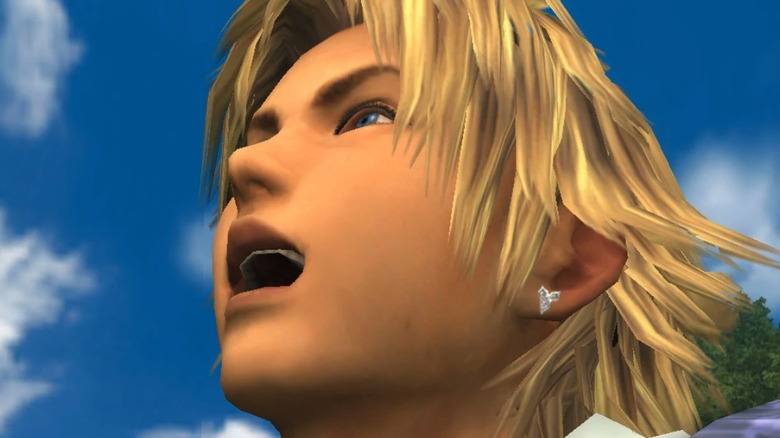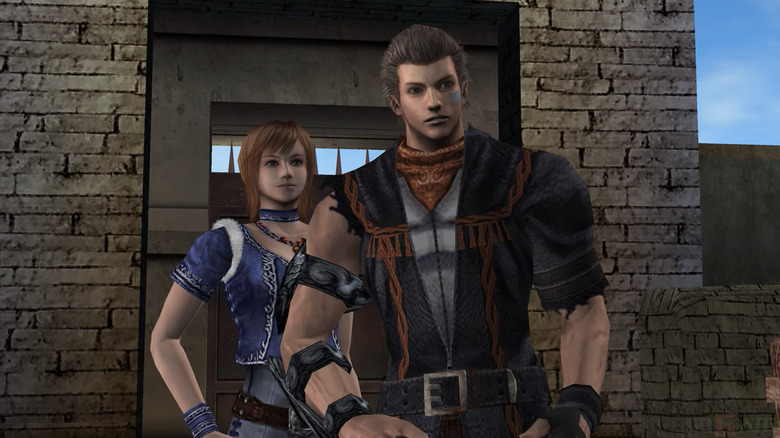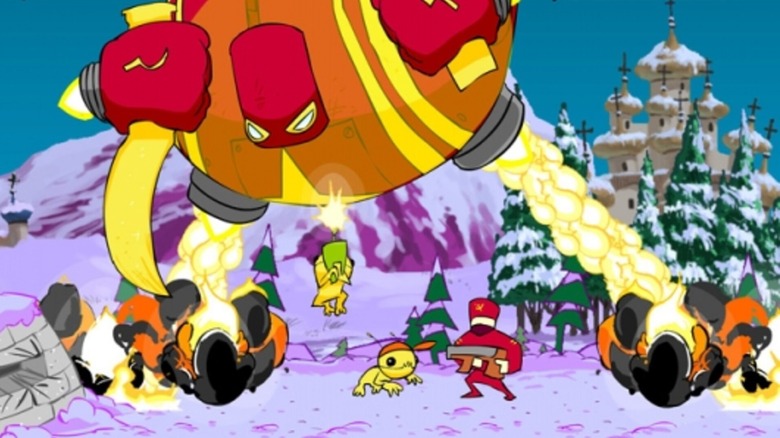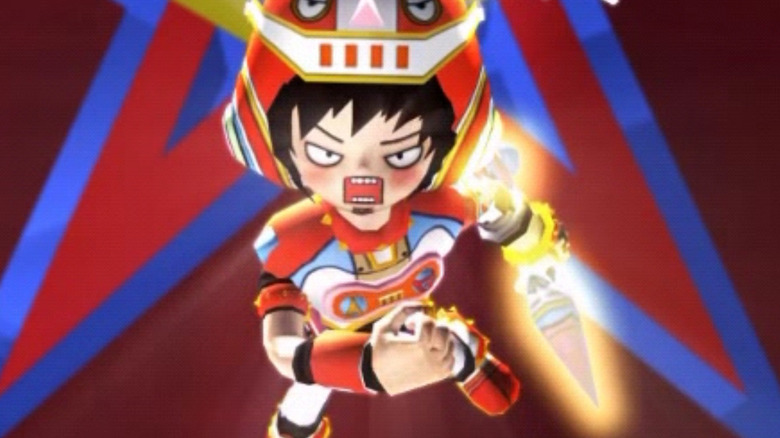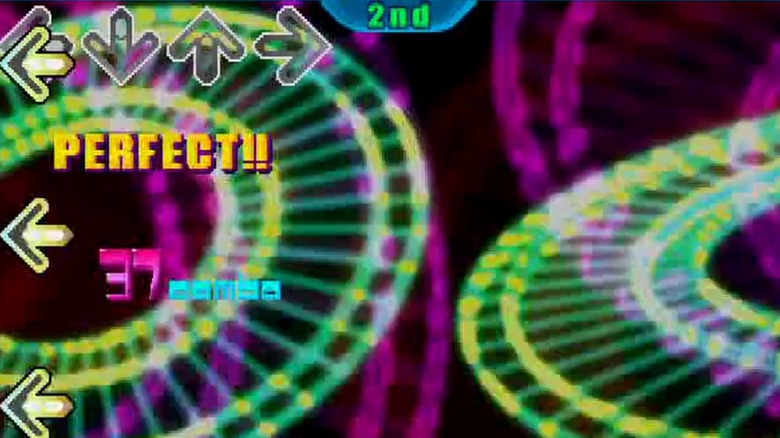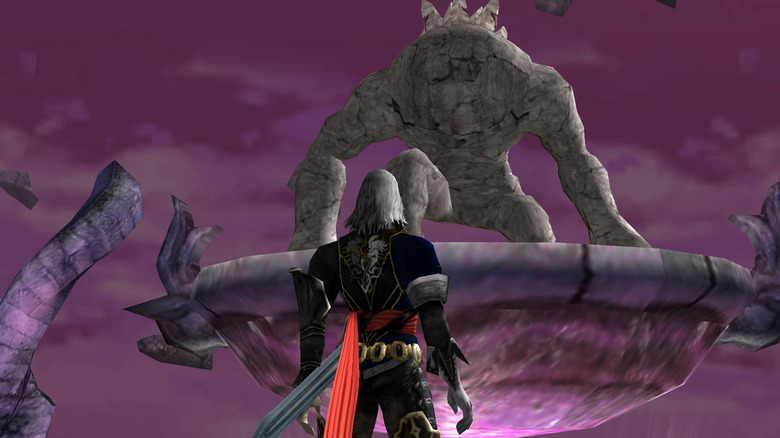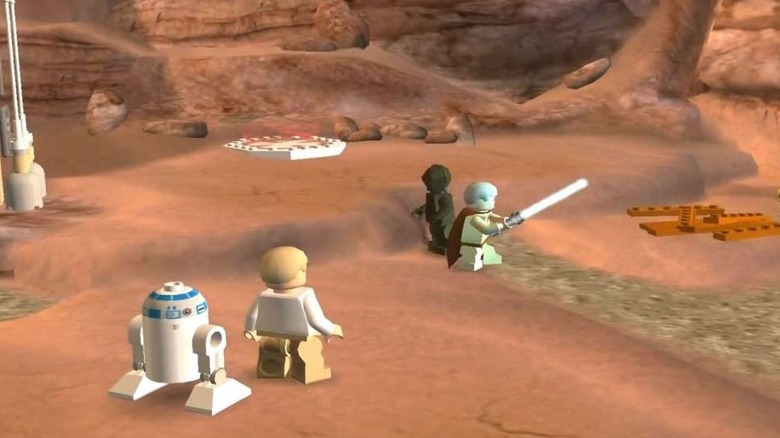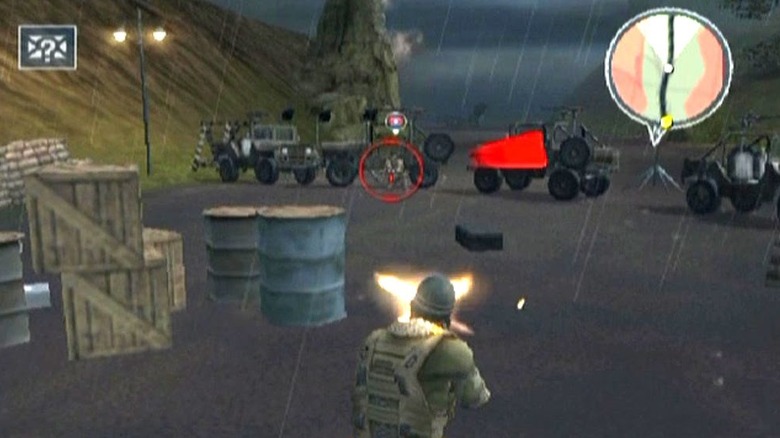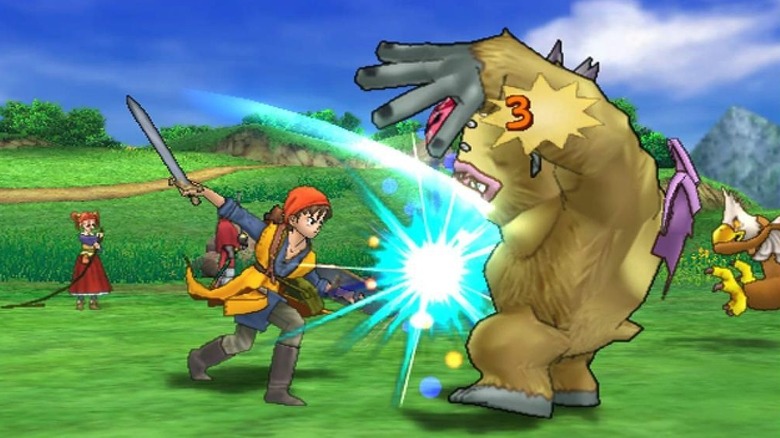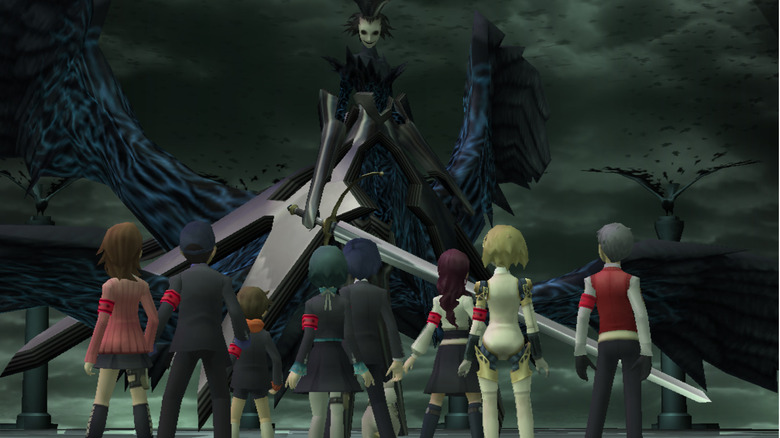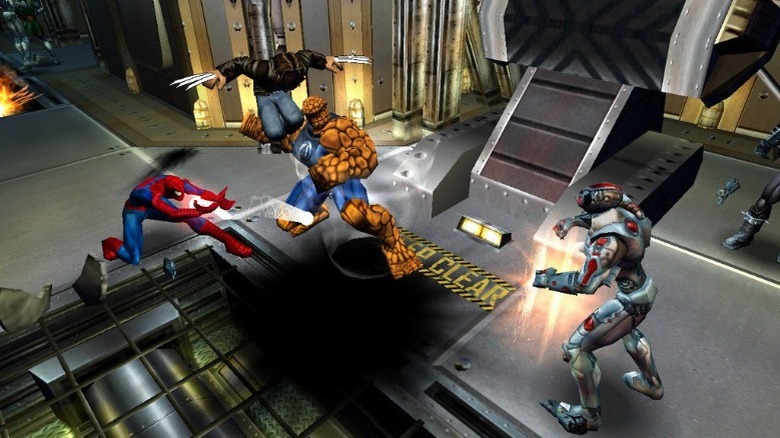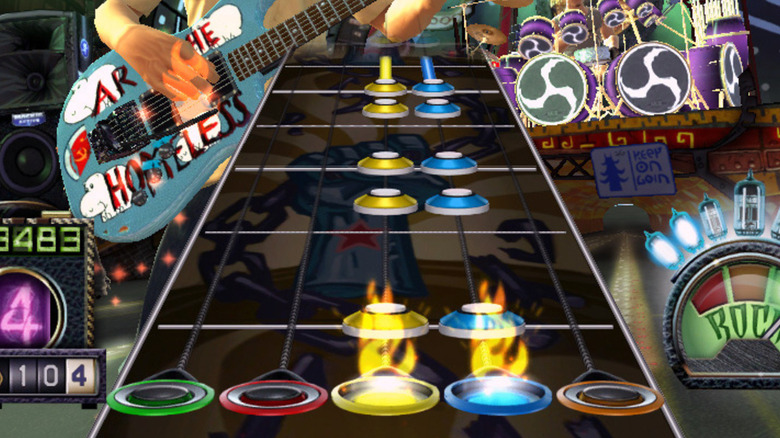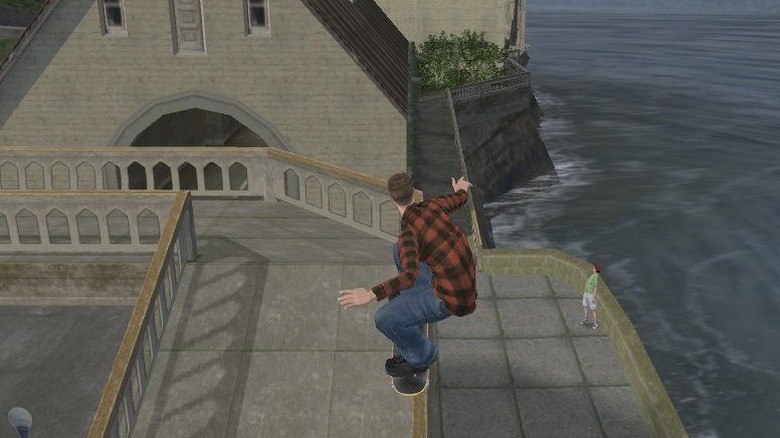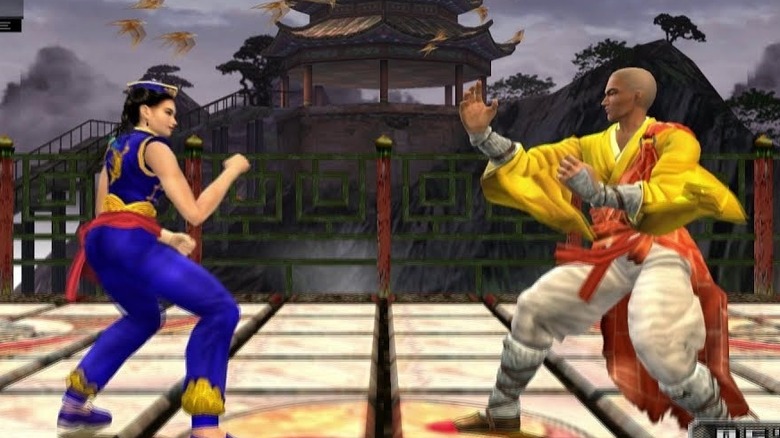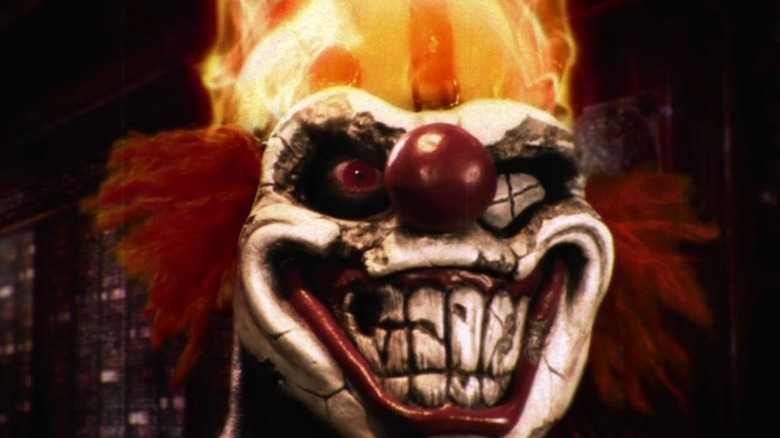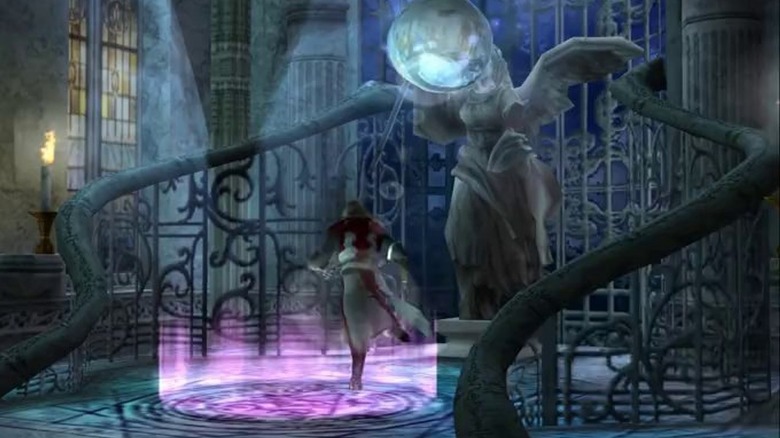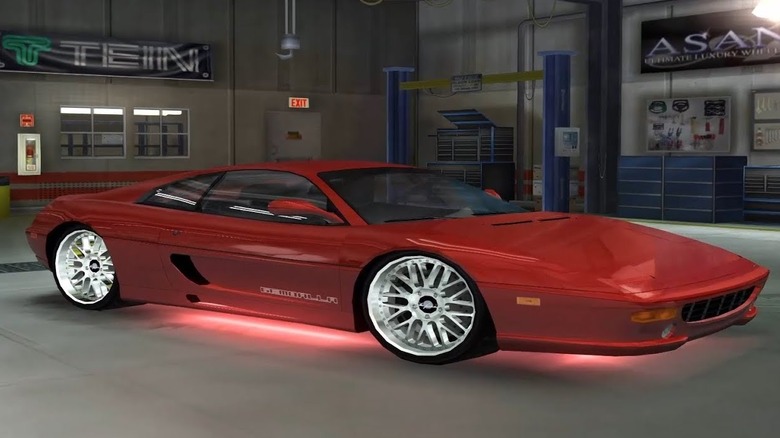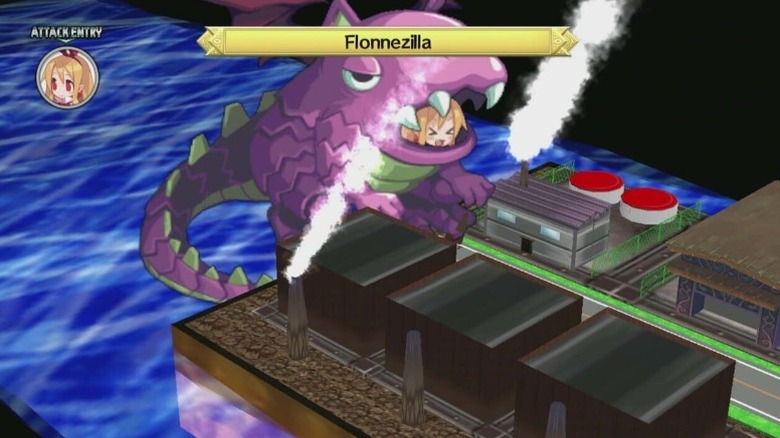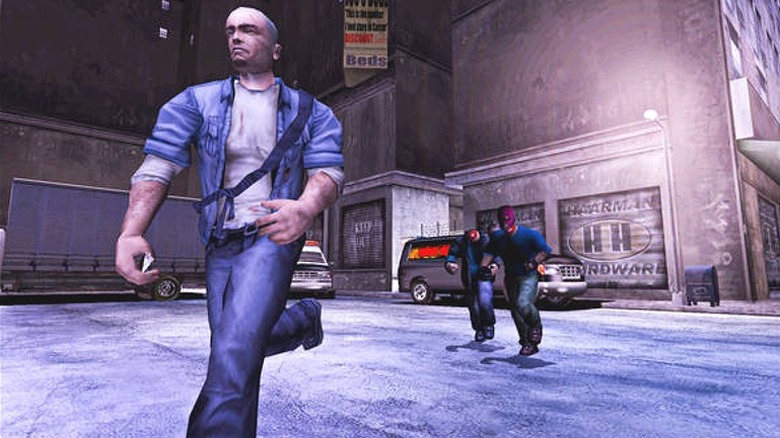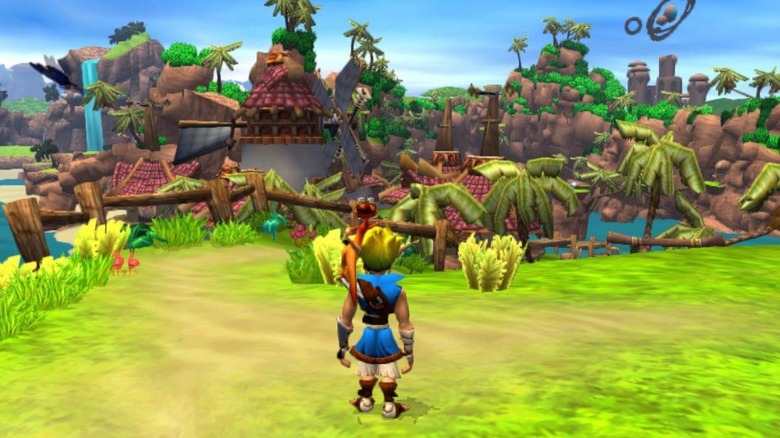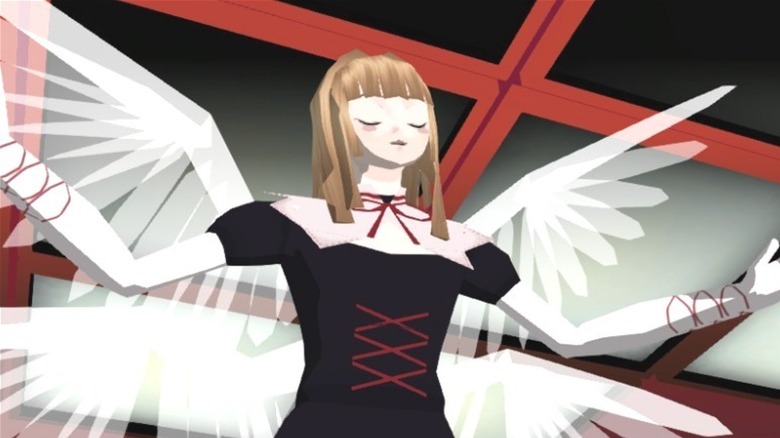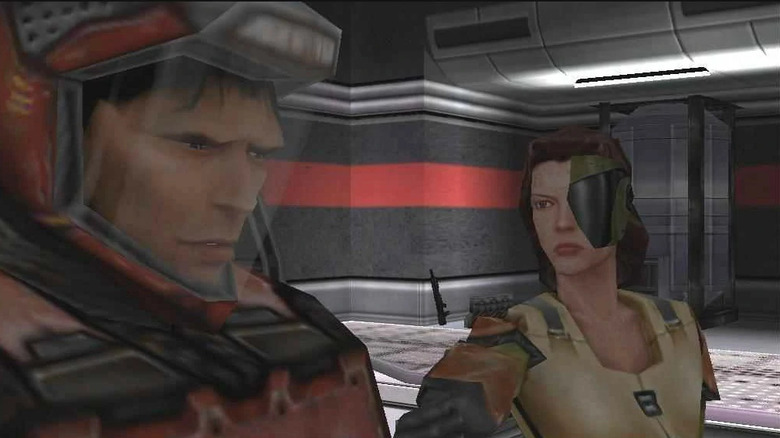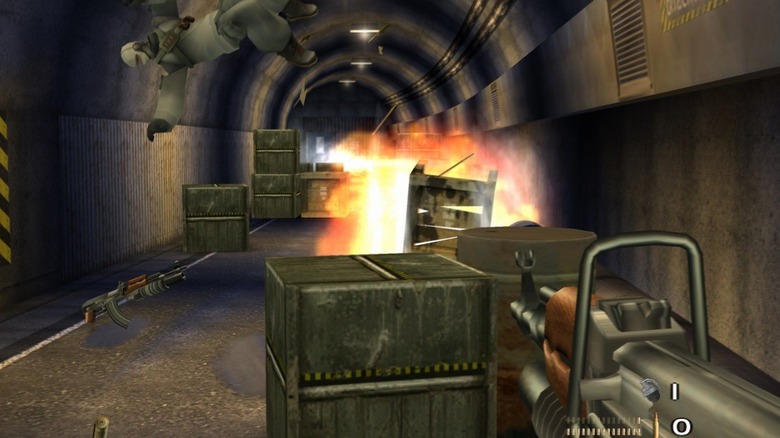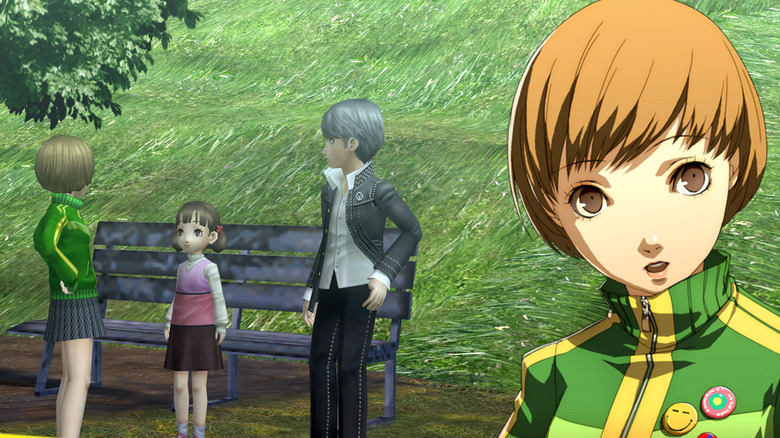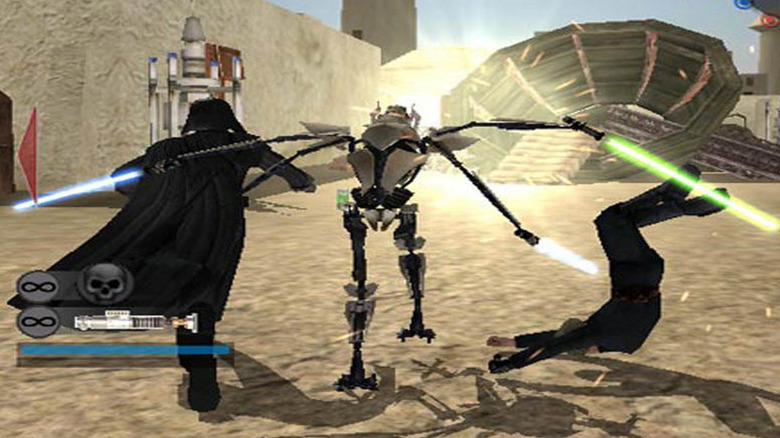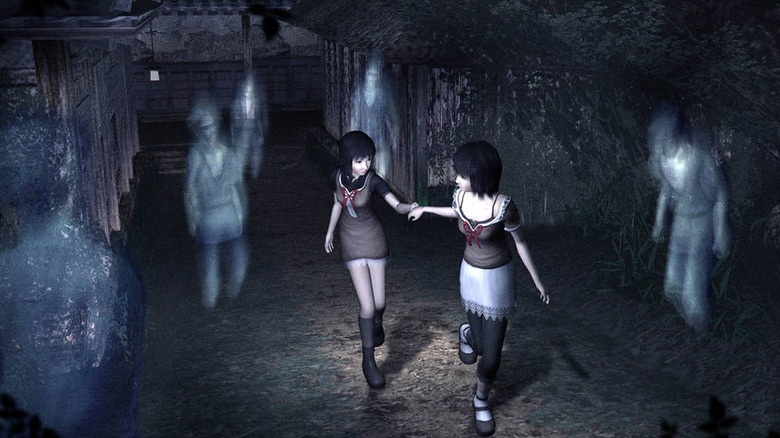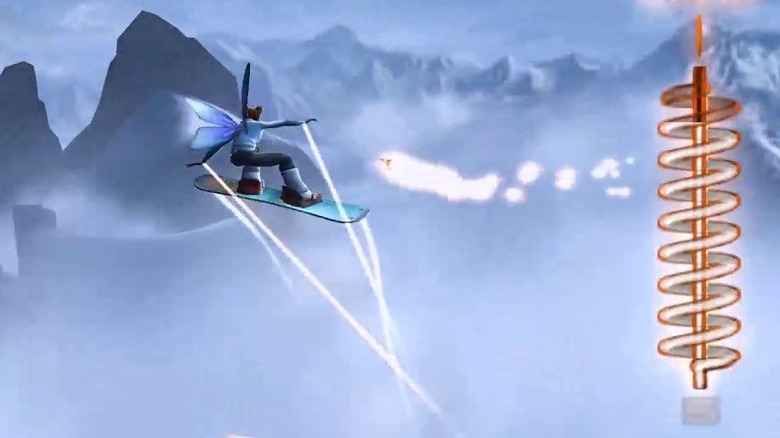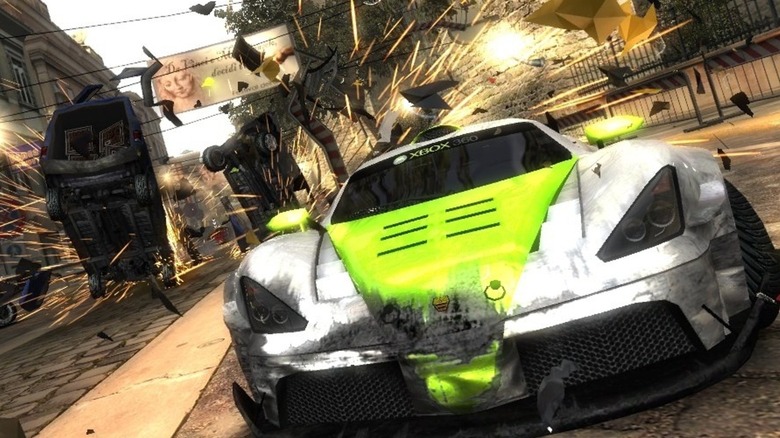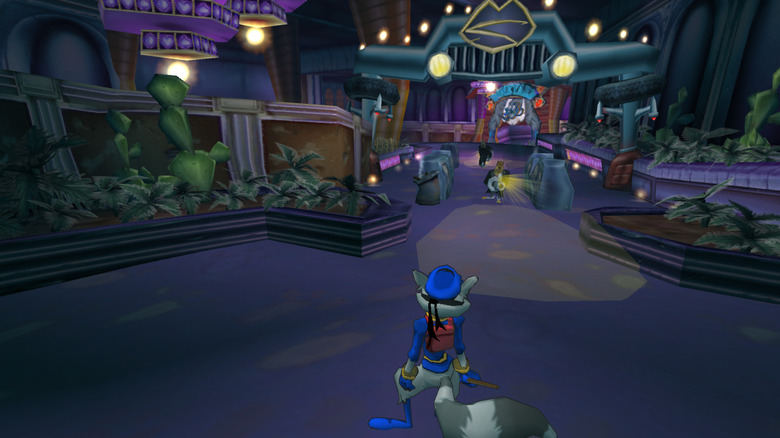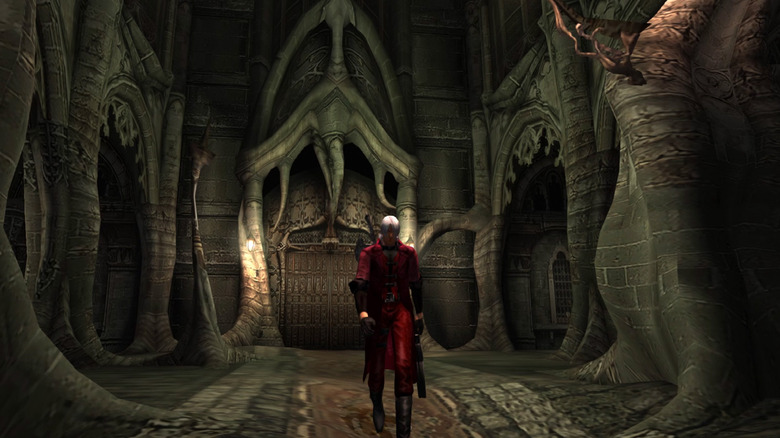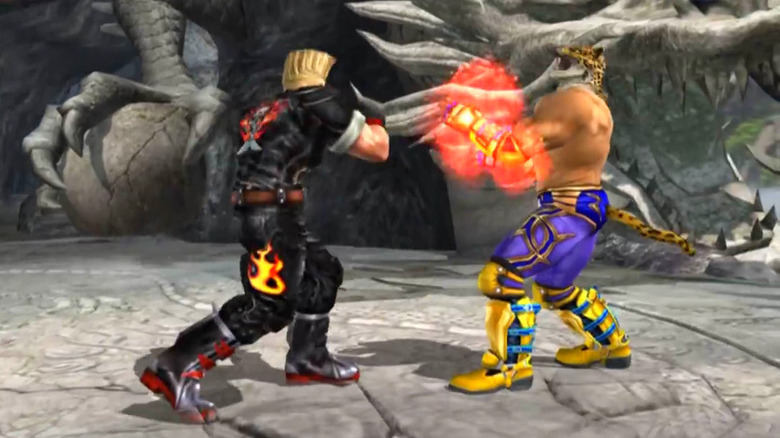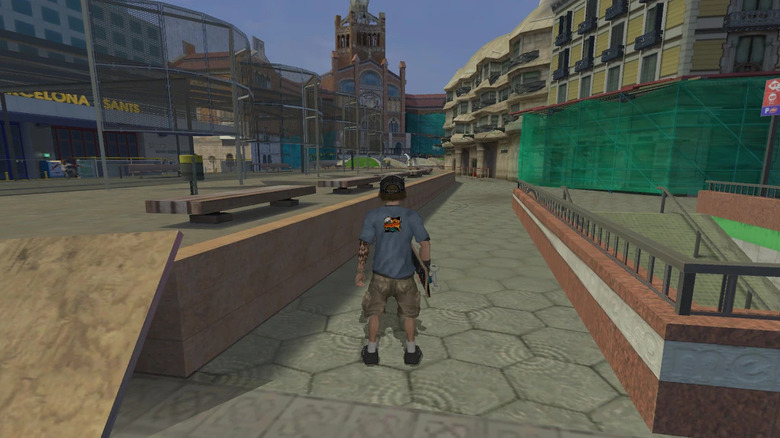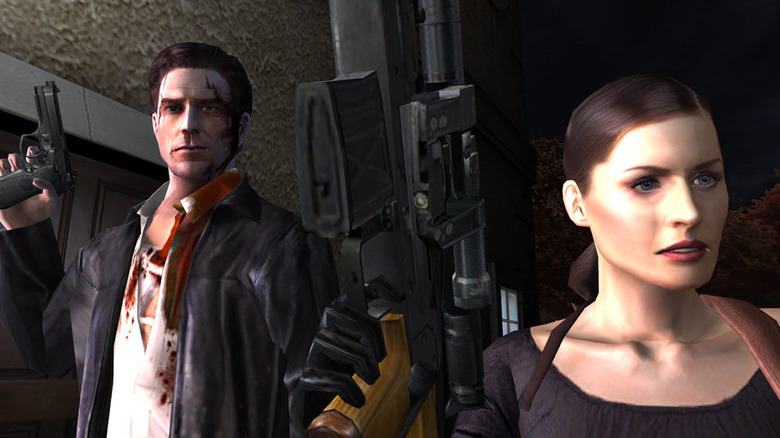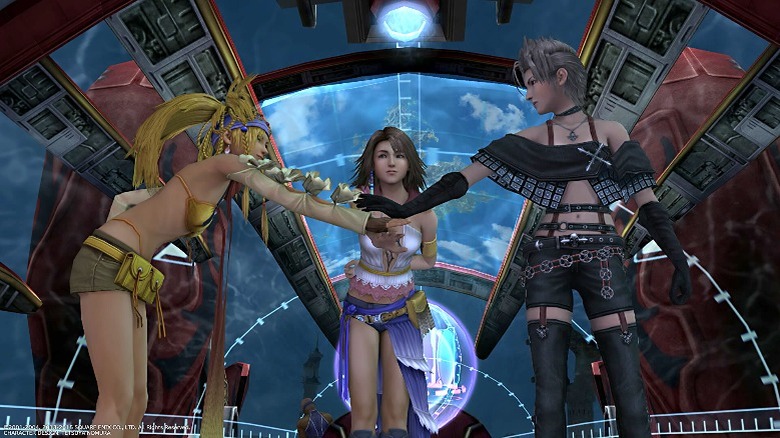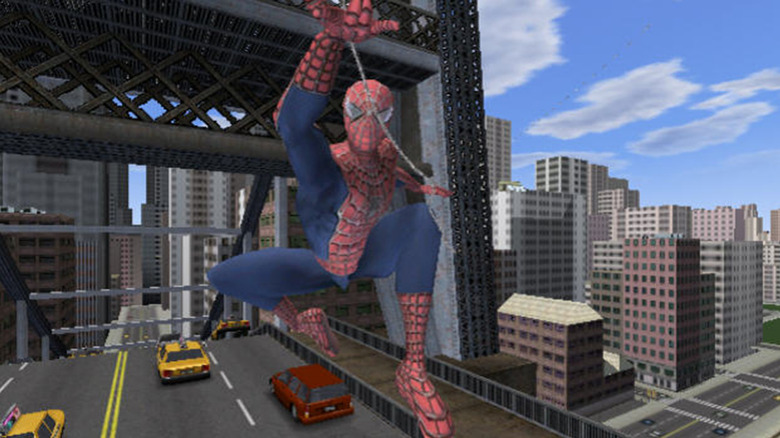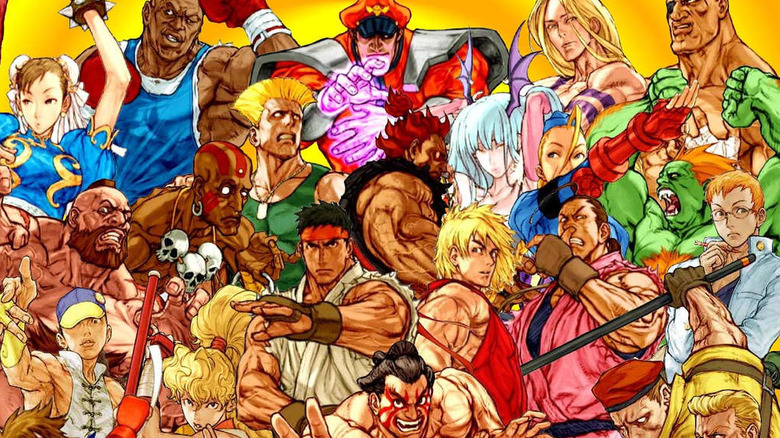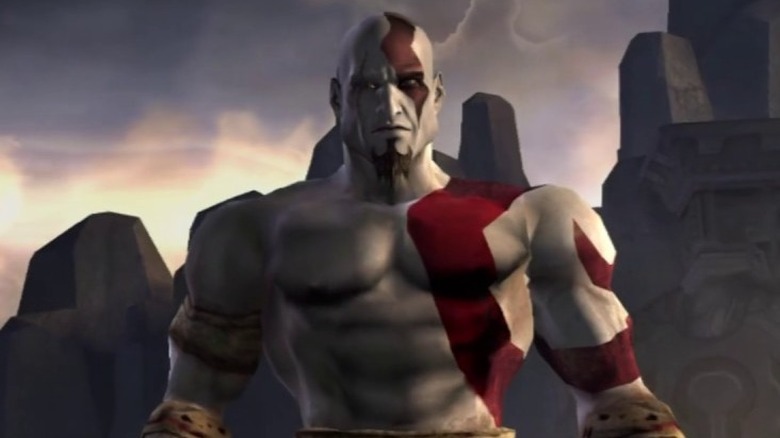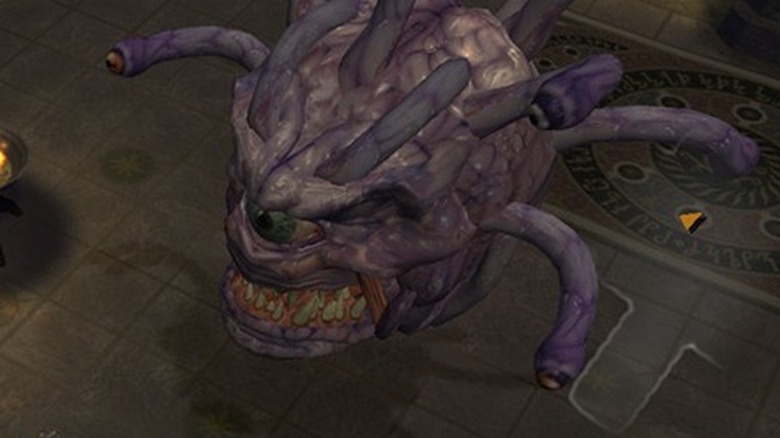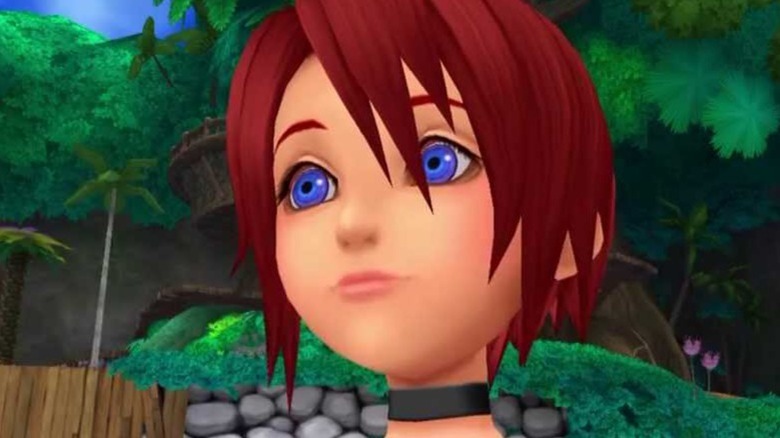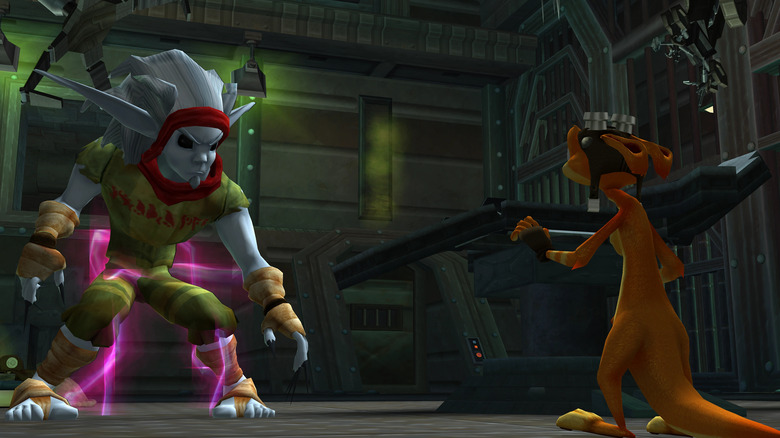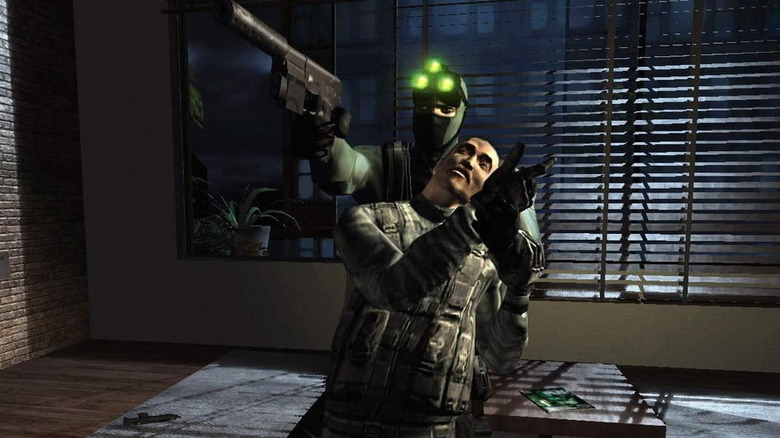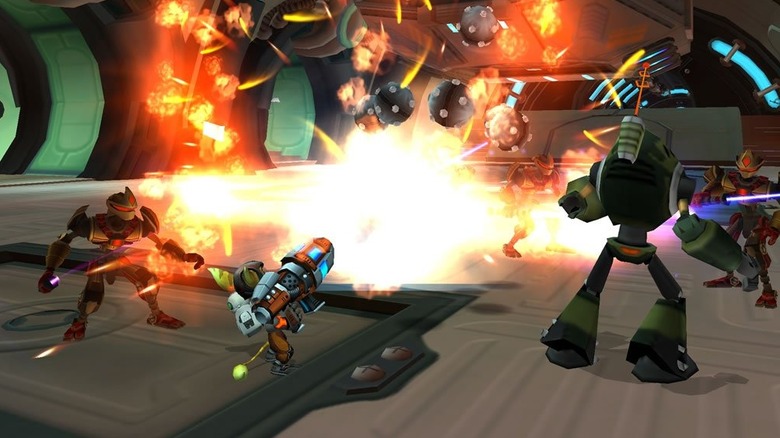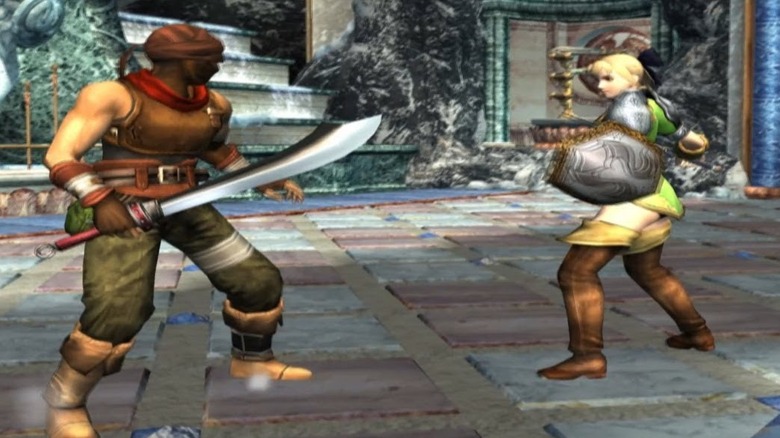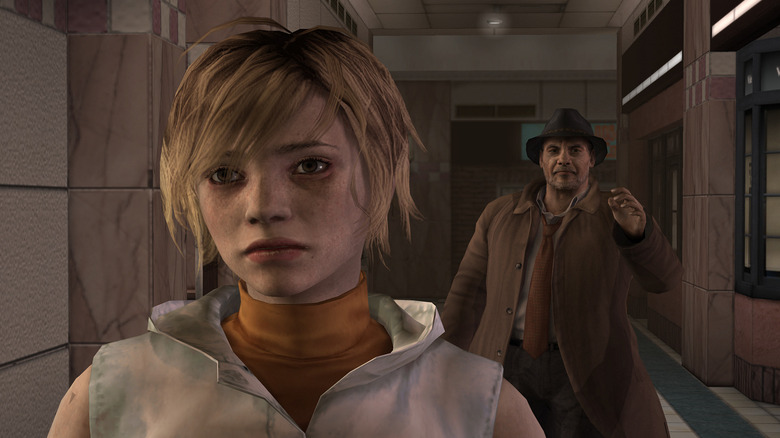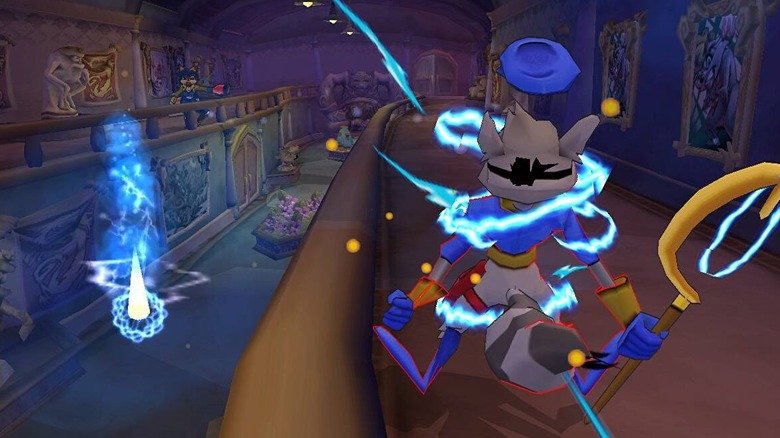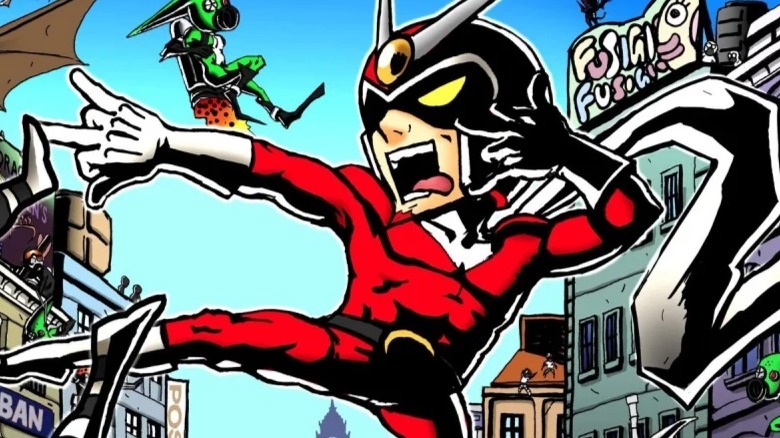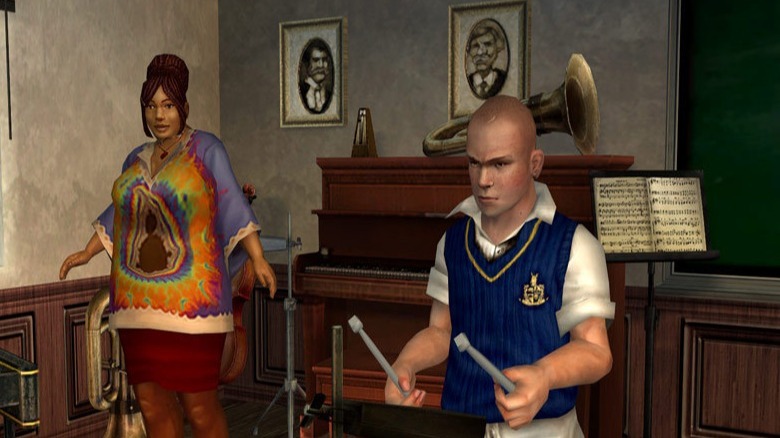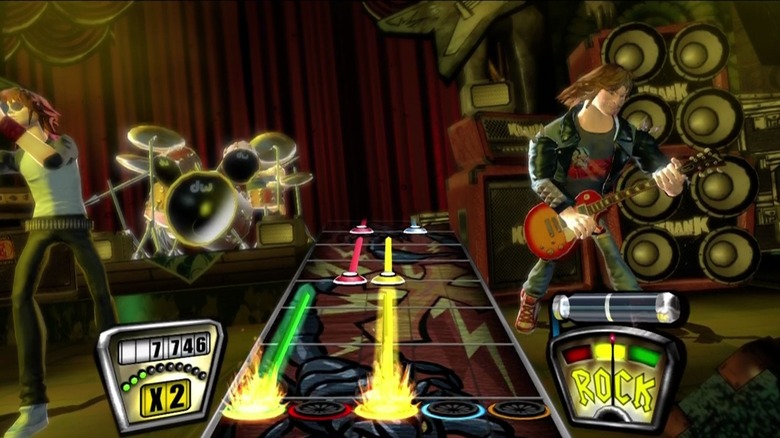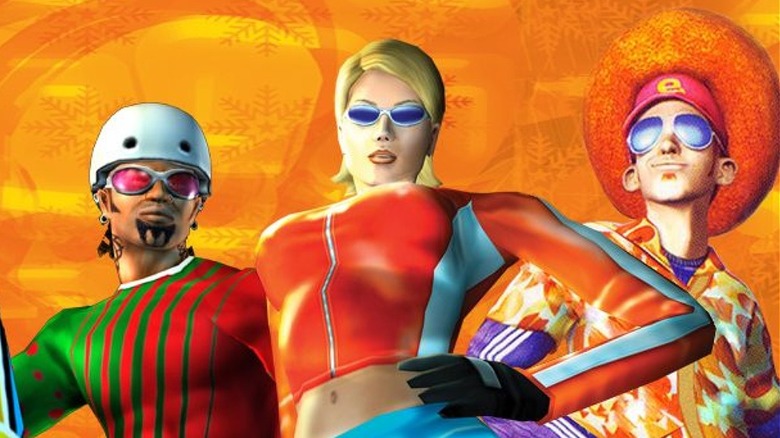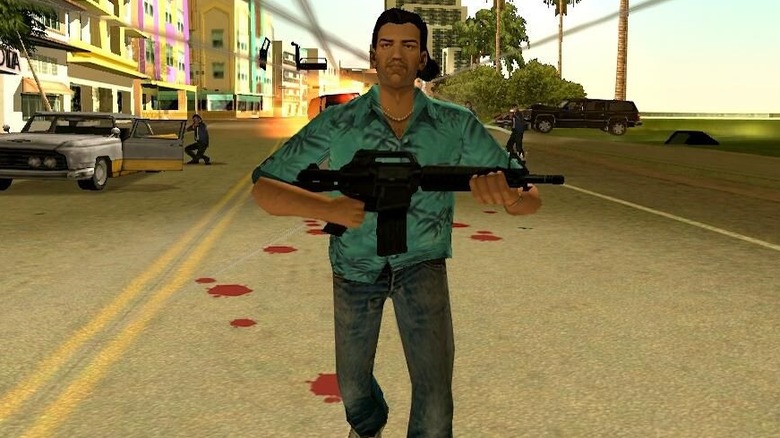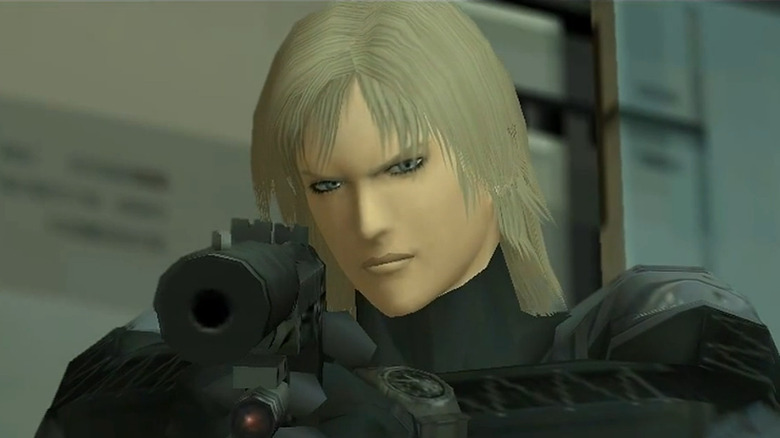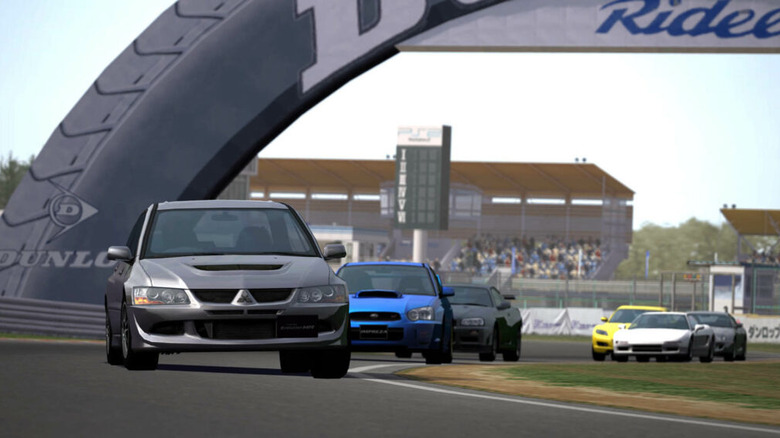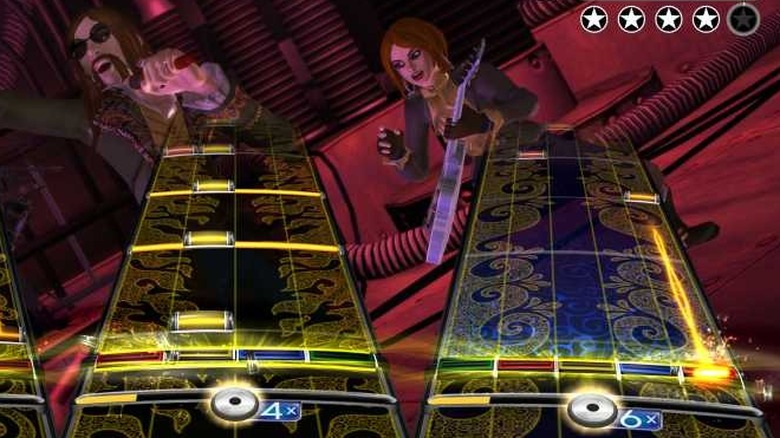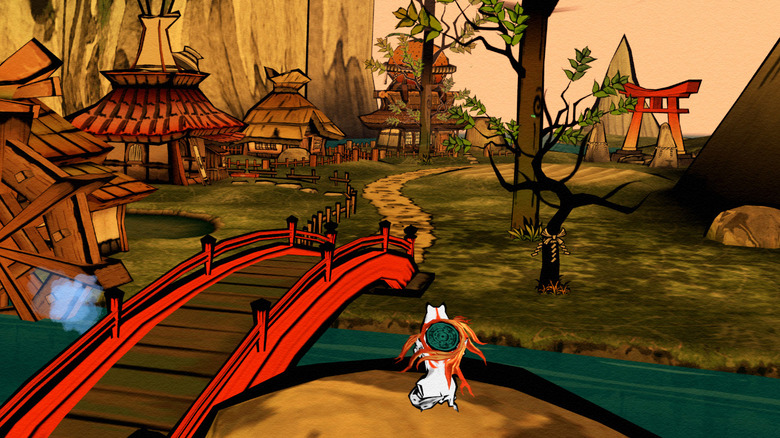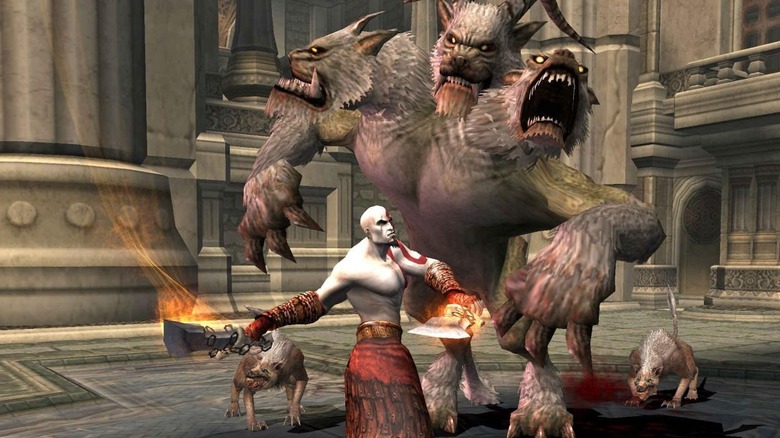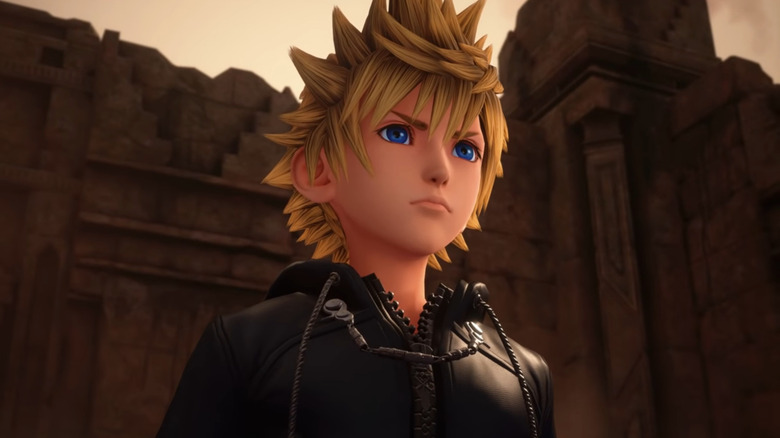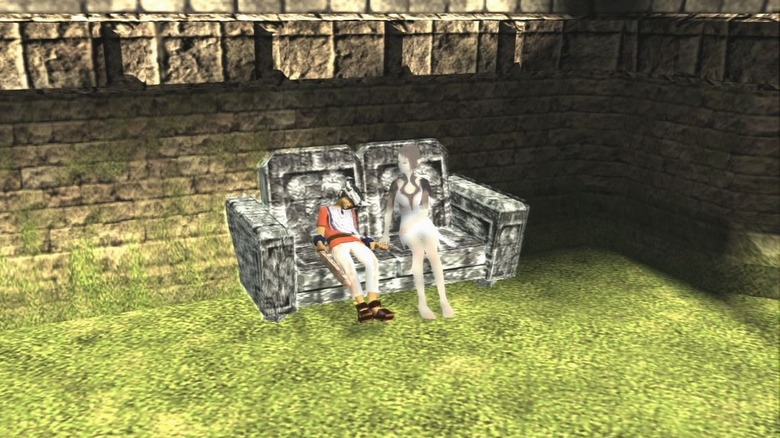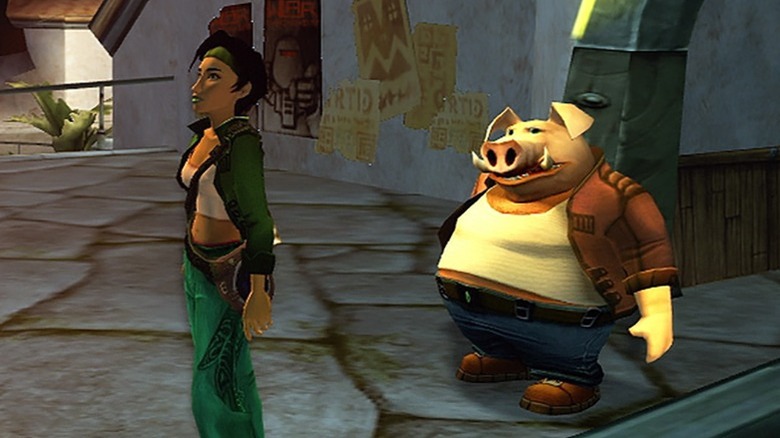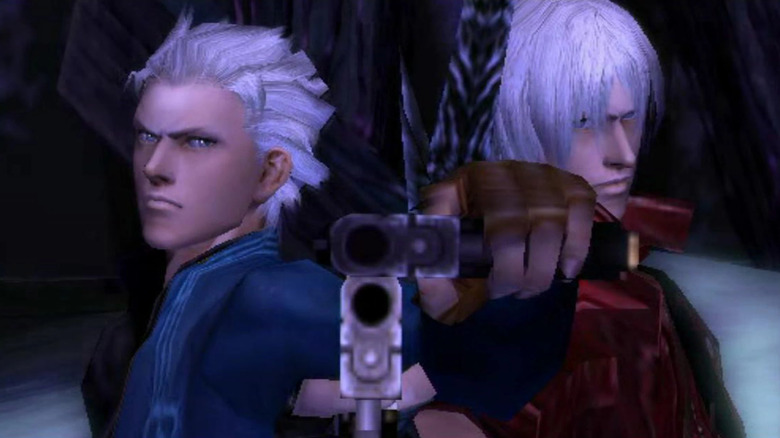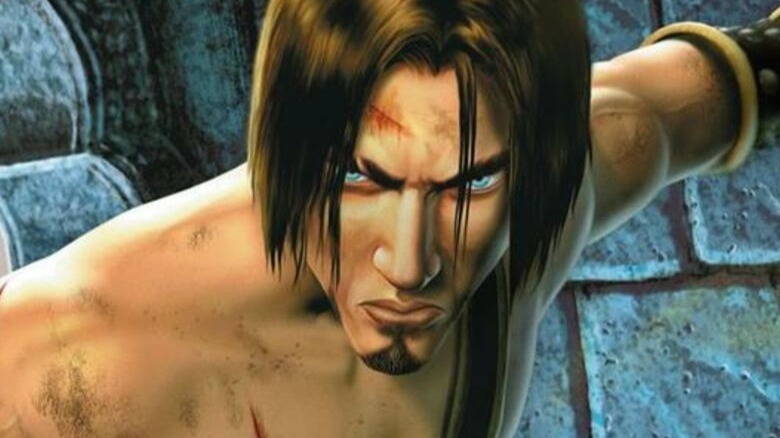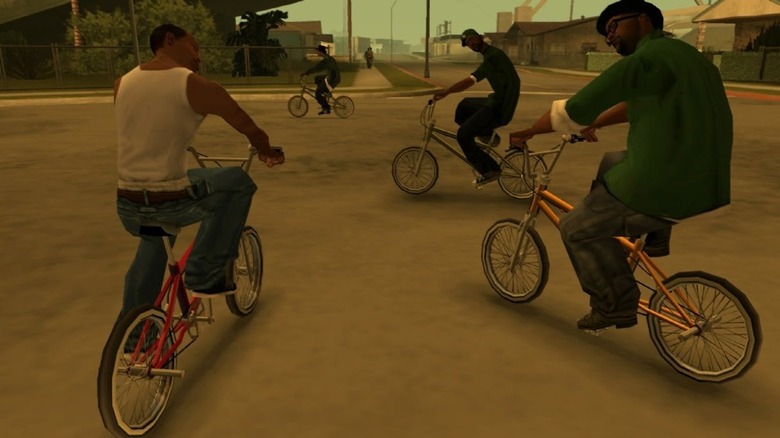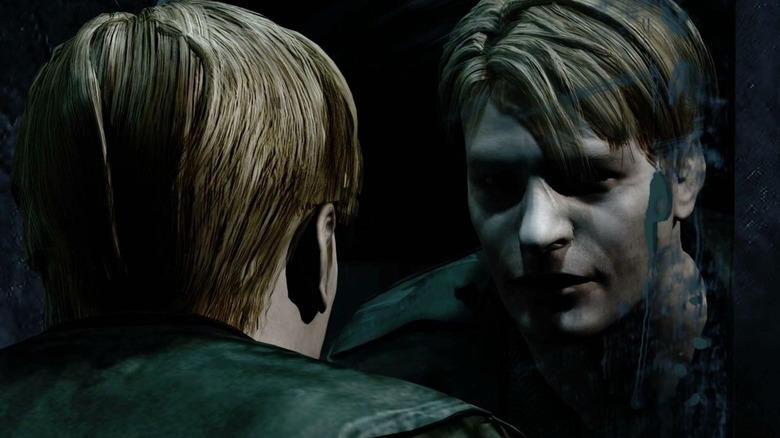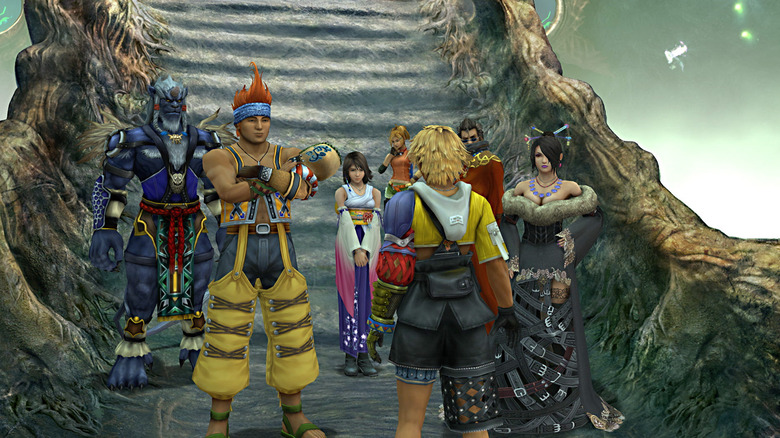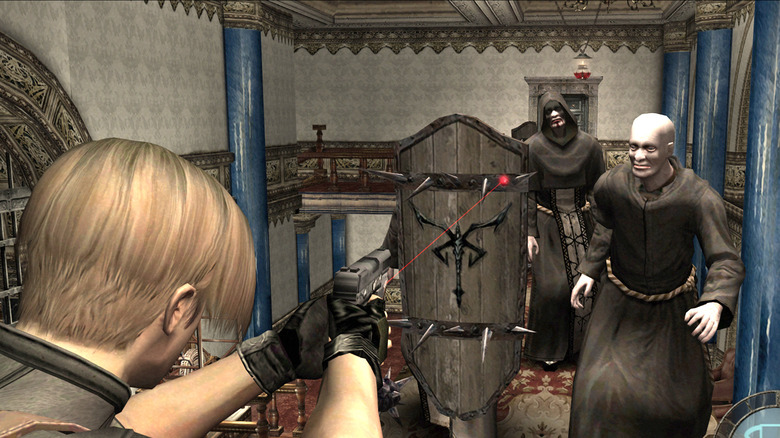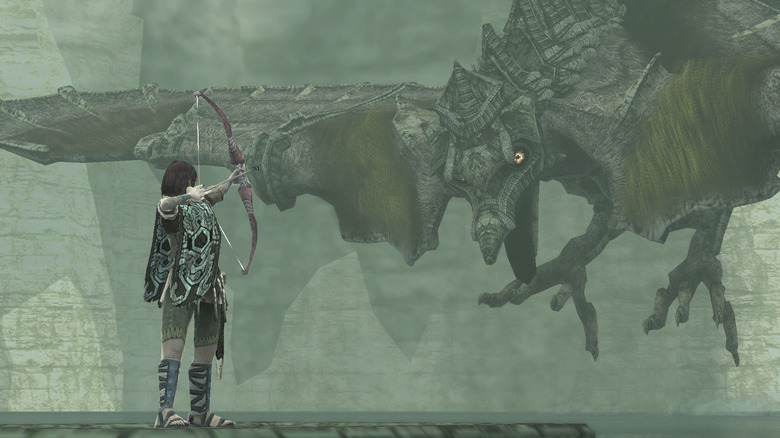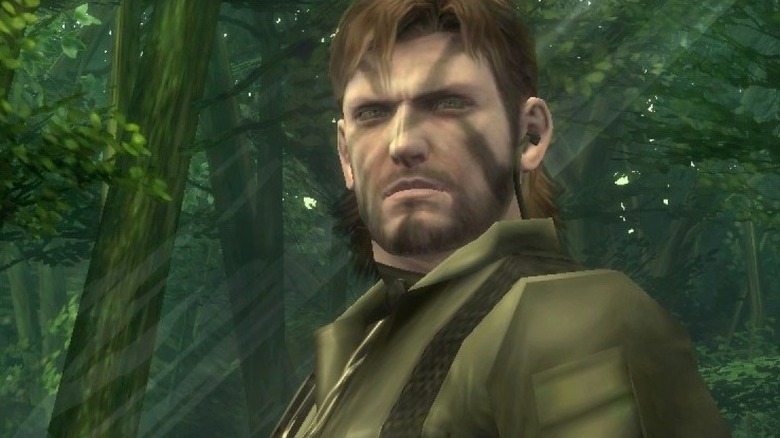The 66 Best PS2 Games Of All Time Ranked
The PlayStation brand has continually transformed over the last couple of decades, becoming a major force in the gaming industry. From its early conception as a Nintendo-owned console (no, really) to the PlayStation 5's status as the console everyone wants but can't seem to track down, Sony's console family has taken a number of risks in the name of home gaming entertainment.
To this day, many fans still point to the PS2 era as their favorite or best stretch of time in PlayStation history. That era is still going strong in many ways, as many games from this time period have been reissued in new and flashy HD collections, and why many of the fan-favorite franchises that launched on the PS2 have continued to receive new installments after so many years.
With that legacy in mind, it's time to take a look back at Sony's second big foray into the home console market. The PlayStation 2 brought with it some truly groundbreaking video games, but the following titles are arguably the best of the best.
66. God Hand
At a glance it is pretty easy to recognize "Viewtiful Joe" and "Okami" as being from the same folks. Capcom's Clover Studio, led by Hideki Kamiya and Shinji Mikami was responsible for the two instant classics. Not so much in the same camp is God Hand, a grittier action game done by the same studio. Although it received some rough reviews at launch, "God Hand" has since become a cult classic (per CBR) that's stayed in the minds of action fans.
An odd adventure that combines Japanese culture, wild west, and pro wrestling, "God Hand" is an unlikely alliance. Gene, a drifter, hides a secret power called the "God Hand," which brings him into direct conflict with demons — and insane action set pieces ensue. The game embraces its silly premise and wears its sense of humor and cheesiness on its sleeve.
What "God Hand" also boasts is a seriously fun combat system. The unwieldy camera system is a bummer, but the freed-up right stick can be utilized for more fighting moves (per IGN). Gene can bob, weave, and roll to get out of hairy situations, and there are plenty of hand-to-hand combat abilities, including sweeping kicks and all kinds of ridiculous juggling options. There's quite a learning curve, but "God Hand" rewards those who commit to learning its ins and outs.
- Release Date: October 10, 2006
- Genre: Action
- Game Modes: Single-Player
- Metacritic Score: 73
65. Alien Hominid
This game hits two different nostalgic notes. "Alien Hominid" was released for the PS2 in November 2004, but it began its life before that as a Flash game on Newgrounds.com (per GameSpot). Even for people who didn't spend the mid-aughts browsing for new web-based games, "Alien Hominid" is beyond entertaining. The story follows a yellow alien creature attempting to retrieve its ship from a series of federal agents. Hilarious violence ensues.
"Alien Hominid" plays like a typical side-scrolling action shooter. It's reminiscent of earlier arcade hits, but its imaginative visuals and offbeat humor set it apart from anything that came before. The game was built for local multiplayer and not only was it packed with mini-games, but it also sports a level editor so players could design their own challenges. Every element of "Alien Hominid" is surprisingly addictive.
-
Release Date: November 1, 2004
-
Genre: Side-scrolling shooter
-
Game Modes: Single-player, Local co-op
-
Metacritic Score: 78
64. Gitaroo Man
This bizarre little title is a PS2 cult classic, as well as an absolute must-play for anyone who considers themselves a video game history buff. Yes, it's a guitar-based rhythm game, but "Gitaroo Man" might as well have been developed on a separate planet from "Guitar Hero." Plus, you don't need a peripheral to enjoy the many charms of what Game Informer called "the best rhythm game ever released" (per Metacritic).
In this vaguely narrative driven game, you play as nerdy child U-1. His life changes one day when his talking dog Puma transforms and grants him access to a weapon of myth — the Last Gitaroo. Using this magical guitar, you must collect opponents' Giatroos in order to become the True Gitaroo man. Taking place in a variety of wacky settings and stages, the gameplay has you attacking and defending in phases. The timing based rhythms can be challenging, but the songs are catchy enough that it isn't a bother to replay a level once or twice. It's worth seeing (and hearing) — all of the jazzy style that "Gitaroo Man" has to offer.
-
Release Date: Feb 19, 2002
-
Genre: Music/Rhythm
-
Game modes: Single-player
Advertisement - Metacritic Score: 82
63. DDRMAX
For a trip down memory lane that will also get you to work up a sweat, look no further than "Dance Dance Revolution." The game is exactly what you'd expect: an arcade dancing experience brought home on your console. "DDRMAX" is chock full of early-2000s house and electronic music. Need to hear "Sandstorm" again? Just can't get enough of "I Like to Move It" by Reel 2 Reel? "DDRMAX" has you covered by throwing in dozens of similar songs to help you get your groove on.
Each song gets announced by the world's most over-the-top DJ, who will also gleefully declare your success or failure with each track. The background videos are a combination of dance club lightshow and the Windows Media visualizer, but the gameplay always hits its mark. Best of all, the game boasts split-screen support, so you and your friends can finally have the dance-off of your lives — if you can manage to track down two dance pads, that is.
-
Release Date: October 28, 2002
-
Genre: Rhythm, dancing
-
Game Modes: Single-player, 2-player split-screen
-
Metacritic Score: 85
62. Castlevania: Curse of Darkness
"Curse of Darkness" was released just two years after "Castlevania: Lament of Innocence." However, despite using the same engine and third-person gameplay, it made serious departures from its predecessor. The storyline also has next to nothing to do with what happened in "Lament of Innocence." This time around, gamers play as Hector, a Devil Forgemaster and former servant of Dracula. Hector finds himself pulled back into his old life when Isaac, another of Dracula's Devil Forgemasters, arranges the murder of his fiance.
"Curse of Darkness" uses similar third-person action mechanics as "Lament of Innocence," but it brings two notable changes to the gameplay. First, Hector doesn't spend much of his time within a castle. Instead he travels to a wide variety of mostly outdoor locations while hunting Isaac across the land. Then there's Hector's Devil Forgemaster abilities, which let him summon creatures called Innocent Devils. These essentially function as pets that have various abilities in and out of combat. "Curse of Darkness" is missing the atmosphere that made its predecessor so memorable, but it supplies enough solid gameplay to stand out among the later "Castlevania" games.
-
Release Date: November 1, 2005
Advertisement -
Genre: Action adventure
-
Game Modes: Single-player
-
Metacritic Score: 70
61. Lego Star Wars 2
The "Star Wars" franchise has a long and proud history in the video game realm, with classics like "Knights of the Old Republic" and the "Rogue Squadron" series being particular standouts. However, one of the franchise's longest-running and most influential game series came from an at-the-time unexpected place: Lego.
The first "Lego Star Wars" spawned a gaming brand that has spanned numerous franchises, including "Indiana Jones" and "Batman." While that first game is undeniably important, it's iterated upon in just about every conceivable way by "Lego Star Wars 2. Boasting more varied and entertaining level designs, an increased number of character abilities, and massively expanded post-game content, "Lego Star Wars 2: The Original Trilogy" is a beautiful example of a sequel done right.
Whether you're making a run on the Death Star or navigating the Ewok villages of Endor's moon, the game provides an endlessly supply of creative scenarios. It's also one of the funnier takes on the "Star Wars" franchise, with plenty of parody worked into the game's cutscenes. Grab a friend for co-op play, and you'll find both one of the best PS2 games and one of the best "Star Wars" games ever made.
-
Release Date: September 12, 2006
-
Genre: Action-Adventure
-
Game Modes: Single-Player, Two-Player Co-op
-
Metacritic Score: 84
60. Mercenaries: Playground of Destruction
Pandemic Studios really had an all-star run during the PlayStation 2 era (per Giant Bomb), releasing the "Destroy All Humans!" series, the "Star Wars: Battlefront" games, and of course, "Mercenaries: Playground of Destruction." "Mercenaries" puts the player on the front lines of an escalating open-world conflict. As one of three selectable mercenaries, you take missions from various global factions staked out in North Korea during a fictional military uprising.
Seemingly taking cues from the console's string of "Grand Theft Auto" games, "Mercenaries" incorporates a lot of the open-world mechanics that you'd expect from a game of its day. There are loyalty meters tied to each faction, various side missions to complete around the map, and plenty of vehicles to hijack and pilot.
The game's big innovations, however, come in the form of two core systems. The first is the "Merchant of Menace" air-drop shop, through which the player can order all sorts of support items, from explosives and hand-held weapons to vehicles and a range of devastating air strikes. The other big addition is the "Deck of 52" mechanic, which hides 52 high-ranking targets around the world to be located and either killed or captured. Taken all together, these mechanics grant the player a ton of freedom to play the game exactly how they want, paving the way for future open-world romps like "Just Cause."
-
Release Date: January 11, 2005
-
Genre: Third-Person Sandbox
-
Game Modes: Single-Player
-
Metacritic Score: 84
59. Dragon Quest 8: Journey of the Cursed King
For fans of traditional JRPG gameplay, "Dragon Quest 8" really hits the spot. Developed by Level-5 and Square Enix, the game received glowing reviews from publications like IGN for its phenomenal design choices and solid voice acting. The story follows a ragtag team of unsuspecting heroes who find themselves pulled into a quest to save the kingdom from an evil spellcasting jester. Though it does sneak in a few surprises, the plot is admittedly pretty paint-by-numbers. Still, "Dragon Quest 8" is clearly laser-focused on giving you the perfect version of that classic formula.
It's not just that the world, monsters, and characters of "Dragon Quest" are beautifully designed; there's also so much to discover. Players can travel across an entire fantasy world with multiple continents and islands to explore. Around every corner is a new surprise, dungeon, or mini-game. Despite its simple premise, "Dragon Quest 8" is an RPG that could hold up to today's standards, which is probably why it was updated for the 3DS in 2017.
-
Release Date: November 15, 2005
-
Genre: JRPG
-
Game Modes: Single-player
-
Metacritic Score: 89
58. Persona 3 FES
Part JRPG and part dating sim, "Persona 3" brought updated mechanics to Atlus' franchise and changed it forever. The game follows a group of high school students in Iwatodai who discover the Dark Hour: a secret time period each night during which regular human beings are trapped in coffins and monsters called Shadows roam the city. The Shadows may be bring about the apocalypse, so it's up to one dorm to save the world.
Gameplay in "Persona 3" is split into time segments. By day, players go to school and connect with their friends, which also increases their fighting abilities through a system called Social Links. By night, they help their dorm mates fight the Shadows and ascend a mysterious tower called Tartarus, unlocking the secrets of the Dark Hour and their own past.
"Persona 3 FES" was released after the original game and included gameplay improvements, new abilities and Personas, and an entirely new playable epilogue to the story (per GameIndustry.biz). It's the best way to play one of Atlus' best games.
-
Release Date: April 22, 2008
-
Genre: JRPG
-
Game Modes: Single-player
-
Metacritic Score: 89
57. Marvel Ultimate Alliance
Superhero video games are unpredictable. They may delight fans with accurate recreations of their favorite comic books, or they can disappoint with clunky mechanics and lackluster stories (looking at you, "Marvel's Avengers"). "Marvel Ultimate Alliance" was thankfully in the former category, and landed well with sometimes-choosy comics fans.
"Marvel Ultimate Alliance" gave players control of a bevy of Marvel's bravest heroes as they journeyed through beat 'em up levels of enemies in pursuit of Doctor Doom. GameSpot's review of the game praised the title's lush settings, boasting some of the most scenic spots in the Marvel universe. The best part of the game was clearly its heroes, though, who hailed from a wide range of comics, including some (at the time) lesser-known titles. More than anything, "Marvel Ultimate Alliance" was just good, simple fun that let players engage with a favorite IP. It doesn't get much better than that.
- Release Date: Oct. 24, 2006
- Genre: Action RPG
- Game modes: Single-Player, Online Multiplayer
- Metacritic Score: 81
56. Guitar Hero 3
After developing the genre-defining "Guitar Hero" and its sequel for Activision, Harmonix moved on to the critically acclaimed "Rock Band" series. As a result, the studio's original plastic guitar rhythm game franchise was handed off to Neversoft, who happily took the reins for "Guitar Hero 3: Legends of Rock." While the game didn't revolutionize the genre in the way that "Rock Band" ultimately did, as noted by GamesRadar at the time, it did provide a fine-tuned and challenging experience for dedicated fans of the series.
Featuring more than 70 songs, many skewing on the heavier and more intense side of rock and heavy metal, "Guitar Hero 3" is more of a deep experience than a particularly broad one. The very aesthetic of the game declares its dedication to classic electric guitar shredding, and unlike its predecessors, "Guitar Hero 3" broke ground by featuring more master track versions of the songs, rather than covers.
Of course, the game is probably most famous these days for its inclusion of Dragonforce's notorious shred-a-thon "Through the Fire and the Flames." And for that alone, "Guitar Hero III" is one of the most iconic games to appear on the PS2.
-
Release Date: October 28, 2007
-
Genre: Rhythm
-
Game Modes: Single-Player, Local Multiplayer
Advertisement -
Metacritic Score: 82
55. Tony Hawk's Pro Skater 4
By 2002, Tony Hawk had become a name-brand franchise dominating every major gaming console worldwide, thanks to the legendary athlete's "Pro Skater" series. 2002's "Pro Skater 4" was the last title in the series until 2015's "Pro Skater 5," marking the end of an era for the franchise for quite a while. And that's kind of a shame — with its gameplay changes, additional modes, and unlockable characters, developer Neversoft improved upon the series' foundation to make one of the best skating games on the PS2.
Following the franchise's usual formula, "Pro Skater 4" sees players travel around the world to skate in different environments, performing tricks and completing challenges to achieve a high enough score to progress. In a major shift from its predecessors, however, "Pro Skater 4" eliminated the time limit in single-player mode to allow players to more freely explore each stage and complete challenges at their leisure. Rounding out the playable roster for this particular installment were "Star Wars" bounty hunter Jango Fett and Eddie, Iron Maiden's mascot as secret characters.
"Pro Skater 4" may not have marked a revolutionary shift in the series, but it remains an excellent experience within the original version of the series, before the franchise rebranded itself. Refining the gameplay elements while improving the multiplayer component, the 2002 game basically stands as the last true classic "Tony Hawk" game.
-
Release Date: Oct. 23, 2002
-
Genre: Sports
-
Game Modes: Single-player, two-player local, up to eight-player online
-
Metacritic Score: 94 (PS2)
54. Virtua Fighter 4
Sega's "Virtua Fighter" franchise has been a force of innovation and technical complexity in the genre for decades. Whether it's trailblazing in the realm of polygonal graphics or paving the way for internet-enabled arcade machines, the series has always had a way to stay relevant. In 2002, Sega released "Virtua Fighter 4" for the PlayStation 2, bringing the console one of its most unique and technical fighting games.
"VF4" has many of the hallmarks of the rest of the series — characters like Akira Yuki, Sarah and Jacky Bryant, an overly convoluted storyline, and a fighting system loaded with evades, reversals, and complex combos. In comparison to its predecessors, "Virtua Fighter 4" is even more mechanically nuanced, with changes to the evade and reversal systems raising the skill ceiling even higher than before. But fortunately, the game also features a detailed training mode to teach players at all levels of the game.
While not as immediately accessible as PS2 competitors like "Tekken 5" or "Soul Caliber 2," "Virtua Fighter 4" brought its own unique flavor to the console, and both critics and fighting game diehards celebrated.
-
Release Date: March 17, 2002
-
Genre: Fighting
-
Game Modes: Single-Player, Local Multiplayer
-
Metacritic Score: 94
53. Twisted Metal Black
Car-based combat is a hard sub-genre to get right. Even after more than two decades, "Twisted Metal" is still this franchise's gold standard. This beloved action game arrived after a handful of disappointing sequels to the David Jaffe-directed "Twisted Metal 2." Jaffe returned for the series' PS2 debut to literally blow all the previous entries out of the water, visually and controls-wise. "Twisted Metal Black" remains one of the wildest and best car combat games ever.
In "Twisted Metal Black," you play as Sweet Tooth or one of the other 14 unique characters in the roster, each boasting their own fun storyline in single-player. The vehicle and weapon variety in "Black" is still unmatched by any other "Twisted Metal," with the 2012 PS3 game as perhaps the lone exception. If you're looking for the PS2's zaniest action behind a steering wheel, look no further.
-
Release Date: Jun 18, 2001
-
Genre: Driving, Action
-
Game modes: Single-player, Local Multiplayer
-
Metacritic Score: 91
52. Castlevania: Lament of Innocence
The first "Castlevania" game to make its way to the PS2 is also arguably the best 3D game in the franchise (sorry, "Lord of Shadows" fans). "Lament of Innocence" is set in the 11th Century and explains how the conflict between Dracula and the Belmont clan began. When Leon Belmont's fiance Sara is kidnapped by a wicked vampire called Walter Bernhard, he charges into Bernhard's castle to get her back. Along the way he encounters demons, Death, and eventually Dracula himself.
The story has enough twists and turns to stay interesting, but the castle itself is the real star of the show. Players get a third-person view on Leon as he battles monsters, wanders winding hallways, and discovers the plethora of secrets buried within the incredibly atmospheric structure. "Lament of Innocence" makes its setting feel lived-in and deeply creepy in a way that few other "Castlevania" games have been able to match. There really aren't any other 3D games in the series that solely focus on castle exploration, and "Lament of Innocence" is very much worth revisiting.
-
Release Date: October 21, 2003
-
Genre: Action adventure
-
Game Modes: Single-player
-
Metacritic Score: 79
51. Midnight Club 3: DUB Edition
Yes, Rockstar is primarily known these days as a developer of open world third-person shooters. What has perhaps gone unnoticed as a result is their lengthy and impressive experience in racing titles. "Midnight Club" already embraces the excitement of street racing culture, but "Midnight Club 3: DUB Edition" is a masterclass in the genre, thanks to its deeper emphasis on car customization and tuning.
"DUB Edition" was the first entry in the "Midnight Club" series to feature licensed cars. Because of this, car customization became a driving point (no pun intended), as players worked to make real cars feel more like their own. Players could tweak performance and cosmetics, adding abundant vinyl, tints, paint, and decal options.
And of course, racing is solid as ever. Where "Gran Turismo" dominates more of a hardcore simulation space, "Midnight Club" excels at a more casual offering. A free roam mode is available in-game, making "Midnight Club 3" feel right at home with other Rockstar offerings. Launching off of ramps at top speeds or crashing into other cars is just as enjoyable as ever.
A lot of praise has been aimed towards the game's different abilities — Roar, Zone, and Aggro — which offer heightened armor, speed, and even time manipulation. They're goofy, unrealistic mechanics, but they are well-implemented. "Midnight Club" has since been in deep hibernation for well over a decade now — which is a shame when games like "DUB Edition" are so good.
- Release Date: April 11, 2005
- Genre: Racing
- Game Modes: Single-Player, multiplayer
- Metacritic Score: 84
50. Disgaea: Hour of Darkness
The "Disgaea" franchise has become known for its colorful characters and outrageously deep tactical combat, and it all began with "Hour of Darkness." Released in 2003, the game made several changes to the typical tactical role-playing game strategy. Players don't take control of heroes but rather the demons and evildoers who reside in a place called the Netherworld. The story primarily follows an egocentric prince named Laharl who's on a mission to claim his throne with the help of anyone he can recruit.
"Disgaea" has an interesting-enough plot and characters with varying levels of charm, but it's really the gameplay that keeps players hooked. There are over 100 characters that can be recruited to the team, and the options for developing them are incredibly complex. Players can manage their levels, classes, gears, and ability to combo with other teammates. Every aspect of the game world, even the merchants, can be beefed up and used to supplement your vicious fighting force as they take on one tactical match after another. All the options make every fight a unique encounter and add near endless replayability to the game.
-
Release Date: August 27, 2003
-
Genre: Tactical JRPG
-
Game Modes: Single-player
Advertisement -
Metacritic Score: 88
49. Manhunt
Between "Grand Theft Auto: Vice City" and "Grand Theft Auto: San Andreas," Rockstar North released what one reviewer called "its darkest, most violent game yet." In "Manhunt," players take control of a death row inmate who has been freed by a sadistic movie director looking to make a snuff film. The director has put together elaborate sets populated by roving gangs that have been hired to hunt the player down. The goal of the game is to survive each set and eventually track down the director to put an end to his project.
"Manhunt" plays like an action stealth game. Players can try to sneak their way through every encounter, or they can use the shadows to help them take down various gangs. Every weapon offers multiple types of brutally violent attacks. The more violent players are, the happier the director gets and the higher they score on each level. The violence gets as graphic as the PS2 allows, which means that "Manhunt" certainly isn't for everyone. However, the stealth gameplay is superb, and each level ramps up the tension with surgical precision.
-
Release Date: November 18, 2003
-
Genre: Third person stealth
-
Game Modes: Single-player
-
Metacritic Score: 76
48. Jak & Daxter: The Precursor Legacy
Before "Uncharted" and "The Last of Us," Naughty Dog rose to prominence with PlayStation classics such as "Crash Bandicoot" and, of course, "Jak & Daxter." Their first platforming adventure, "The Precursor Legacy," remains a classic and fan favorite to this day. In this first outing, the titular character set out on a journey to stop the evil Gol and Maia after Daxter is transformed into an adorable "Ottsel."
Misty Island is where the story takes place and it's a vibrant setting, to say the least. It may be one land mass, but Misty Island is home to unique landmarks like lush jungles, ancient ruins, and even snowy hilltops. On the gameplay front, "Jak and Daxter" is a classic action platformer with plenty of moves that should be familiar to genre fans. There's a double jump, Crash Bandicoot-esque spin move, and a roll-jump that looks like it was pulled right out of "Donkey Kong Country." But make no mistake, "The Precursor Legacy" has its own fun twists. The PS2 game tosses tons of content at the player. Driving floating speeder-bikes through the air, net fishing, and other mini games keep the players on their toes. The glue that holds all of these elements together is the solid action and fun humor that feels like classic Naughty Dog.
- Release Date: December 3, 2001
- Genre: Platformer
- Game Modes: Single-Player
- Metacritic Score: 90
47. Killer7
This Capcom collaboration between "No More Heroes" creator Suda51 and Shinji Mikami is a one-of-a-kind shooter that has reached cult status in the years since its release. "Killer7" transcends game genres, blending on-rails shooting with adventure game-style choice and consequence. Its distinct cell-shaded style was polarizing at the time (the Metacritic average is very mixed), but has helped the game stand the test of time. To this day, no other game looks quite like "Killer7."
Nearly every aspect of the game's design was unusual for the time. The story was far from the popcorn fare gamers were used to in 2005. Suda carefully weaves a noir story of political intrigue around a group of assassins called the killer7, who are actually (spoilers) a series of souls being controlled by one old man. It's... a lot to comprehend, and that's just the set up. As the game goes on, you control all seven of the assassins, each of which have different skills to master. The end result is a tale that combines bizarre stylized action and political intrigue.
-
Release Date: Jul 7, 2005
-
Genre: Action Adventure, Shooter
-
Game Modes: Single-player
-
Metacritic Score: 70
46. Red Faction
"Red Faction" takes place in a mining colony on Mars. The workers on Mars are living out a dystopian nightmare as their labor is exploited, and they're unable to leave as a virus known only as "The Plague" infects worker after worker. Players take on the role of Parker, a new arrival who's hoping for the best. What he finds instead are heightened tensions between workers and guards that quickly erupt into a full blown revolution.
"Red Faction" is far from the first shooter set in a colony on Mars, but as noted by IGN, it has something games before it lacked: fully destructible environments. The game features fancy new Geo-Mod technology that allow players to break down doors, blow up bridges, and generally cause chaos and mayhem everywhere.
Released just six months before "Halo: Combat Evolved," "Red Faction" gave players a wide array of weapons, maneuverable vehicles, and massive battles well before they all became FPS standards. It's without a doubt one of the PS2's best first-person shooters.
-
Release Date: May 21, 2001
-
Genre: First-person shooter
-
Game Modes: Single-player
-
Metacritic Score: 88
45. TimeSplitters 2
The PlayStation 2 was an interesting system for first-person shooters. Microsoft had a corner on the console shooter market from the moment the original "Halo" released. But that's not to say that the PS2 didn't still have some excellent — and in some cases, curiously experimental — first-person shooters of its own. Games like "Killzone," "Project: Snowblind," and a cavalcade of World War II shooters all attempted to stake out a niche, but the PS2's best first-person shooter may be "TimeSplitters 2."
After working formative console shooters like "GoldenEye 007" and "Perfect Dark" on the Nintendo 64, a number of Rare employees departed to form new studio Free Radical. The group's first game, "TimeSplitters," took many cues from those N64 hits, featuring a level-based single player campaign and a range of local multiplayer options. And then "TimeSplitters 2" takes the solid ideas at the core of its predecessor — mainly the fast-paced shooting model and the structure of theming each level with a different temporal setting — and makes them great.
From taking down zombies in a gothic cathedral and fighting through the mean streets of a cyberpunk metropolis to infiltrating a Soviet military complex, "TimeSplitters 2" puts a constant menu of fresh ideas before you. And though it released on other consoles as well, critics favored the PS2 version over the rest.
-
Release Date: October 8, 2002
-
Genre: First-Person Shooter
-
Game Modes: Single-Player, Local Multiplayer
-
Metacritic Score: 90
44. Persona 4
Few JRPG franchises have received as much overall acclaim as the games in the "Persona" universe, which itself is a spinoff of the "Shin Megami Tensei" games. And while there have been many distinct and successful entries in the franchise, "Persona 4" makes a strong case as the best of the bunch.
Set in the fictional Japanese town of Inaba, the game's story follows a group of teenagers investigating a series of gruesome and mysterious murders. As is true for most games in the series, gameplay is split between two core modes — dungeon-crawling battle gauntlets where you capture, combine, and level up various creatures/spirits called Personas, and slice-of-life simulation segments in which you develop "Social Links" with other characters.
While the gameplay and the story are both absolutely solid, "Persona 4" truly shines in its smaller character moments. Whether you're rehearsing monologues with the drama club, practicing basketball in the gym after school, or journeying to the Meat Dimension on a date with Chie, you'll surely be taken with the charming atmosphere and rich world-building. And because it was released a year and a half after the PlayStation 3 become available to gamers, "Persona 4" is also one of the last true masterpieces ever created for the PS2.
-
Release Date: July 10, 2008
-
Genre: RPG
-
Game Modes: Single-Player
-
Metacritic Score: 90
43. Star Wars: Battlefront 2
Combining the multiplayer mayhem of "Battlefield" and the military sci-fi worldbuilding of "Star Wars" sounds like a match made in Heaven, and as it turns out, it is (at least when done right). The original "Star Wars: Battlefront" released to great reviews in 2004, and it's sequel perfected the package a little over a year later.
For starters, "Battlefront 2" expands the base gameplay of the original with more maps, more modes, and more character classes to pick from. There's a whole single-player campaign, or multiple other modes that chain the multiplayer-style battles together in entertaining ways. But in addition to simply refining the concept, "Star Wars: Battlefront 2" adds a bevy of entirely new and notable elements to the gameplay, including space battles and the ability to play as named characters from the movies.
Earn enough points on the battlefield as a grunt, and you earn the opportunity to respawn as a Jedi, Sith, or bounty hunter. There's little that's more fun than hopping around the fight as Yoda or Darth Maul, slicing through every tank and droid in sight. The space battles also provide a fun change in pace, while an objective-based game mode encourages different styles of play. You can even play as an Ewok! At least there's one "Star Wars: Battlefront II" that didn't go horribly wrong.
-
Release Date: November 1, 2005
-
Genre: Third-Person Shooter
-
Game Modes: Single-Player, Local Multiplayer, Online Multiplayer
-
Metacritic Score: 84
42. Fatal Frame 2: Crimson Butterfly
"Fatal Frame 2" arguably deserves to be mentioned in the same breath as other PS2 horror classics like "Silent Hill 2" and "Resident Evil 4." This standout entry from the frightening Japanese photography/survival horror series does a lot more than just let you snap pictures of ghosts; it also makes your spine tingle while you're at it.
In "Crimson Butterfly," Sisters Mio and Maya Amakura make a journey to revisit a childhood memory where they follow a crimson butterfly to a mysterious village. Here, the souls of the damned roam and the only way to defeat them is with your special camera, the Camera Obscura. Featuring a one-of-a-kind combat system, the Camera Obscura acts as your main tool through the puzzles and trails of "Fatal Frame 2." Innovative gameplay, a 2000s Japanese horror vibe, and a mature storyline with multiple endings make "Fatal Frame 2: Crimson Butterfly" a rewarding and unsettling experience.
-
Release Date: Dec 10, 2003
-
Genre: Horror, Action Adventure
-
Game Modes: Single-Player
-
Metacritic Score: 81
41. SSX3
The PS2 belonged to a golden age of sports games The "Tony Hawk" franchise cornered the market on skateboarding games, and "SSX" became the go-to brand for snowboarding adventures. The series began its life on the PS2 with "SSX" and "SSX Tricky," but this installment changed the game. When "SSX3 landed on the scene, it was full of all the racing and wild tricks that fans had come to expect. However, it also came with some welcome improvements to the formula that took things to a whole new level and still make the game feel fresh.
"SSX3" has three different mountain slopes that are each loaded with their own races, backcountry areas, and a treasure trove of secrets to discover. Players have the option of tackling different races or freely exploring the entire mountain range at their leisure. Reviewers at the time were particularly impressed that "SSX3" managed to render its mountainous world with barely any load screens, giving players nearly total immersion into the snowboarding life. Whether playing through the story mode alone or going head-to-head with a friend via split-screen, "SSX3" still feels like the peak of the snowboarding game genre.
-
Release Date: October 20, 2003
-
Genre: Snowboarding
-
Game Modes: Single-player, Split-screen multiplayer
Advertisement -
Metacritic Score: 93
40. Burnout Revenge
Criterion Games injected the racing game genre with a shot of adrenaline with its "Burnout" series, which really shined on the PlayStation 2. Though the beloved "Burnout 3: Takedown" is the game responsible for many of the franchise's most iconic aspects — such as Crash mode, the ability to boost at any point, and of course, the titular takedowns — its successor iterates on everything in meaningful ways.
Simply put, "Burnout Revenge" is a bigger, shinier, and more complete version of what worked in "Takedown," with robust additions to Crash mode and a number of added in-race features, such as the explosive "Crashbreaker" ability and "traffic checking," which allows players to knock road vehicles directly into competitors. The result is arguably the most action-packed game in the whole "Burnout" franchise, especially since its successor, the acclaimed "Burnout Paradise," ended up exchanging some of the mayhem for open-world exploration.
From the sheer number of vehicles and events available throughout the single-player mode to the technical polish of the game (a benefit of releasing late in the PS2's life cycle), "Burnout Revenge" is one of the most impressive driving games of its generation.
-
Release Date: September 13, 2005
-
Genre: Racing
-
Game Modes: Single-Player, Local Multiplayer, Online Multiplayer
-
Metacritic Score: 89
39. Sly Cooper and the Thievius Raccoonus
"Sly Cooper" is one of the most memorable franchises to come out of the PS2 era. Developed by Sucker Punch Productions, the same studio behind games like "Infamous" and "Ghost of Tsushima," the first "Sly Cooper" game introduced players to a cartoonish world of animal thieves and puzzle platforming. The eponymous Sly Cooper is a raccoon who comes from a long lineage of master thieves. When Sly was a child, a group of criminals killed his father and stole his family's book of secrets, the titular "Thievius Raccoonus." Now Sly and his friends are determined to steal it back.
Players control Sly through a huge array of stages that present unique challenges. From breaking and entering to safe cracking to making the perfect getaway, Sly will teach everyone how to become a master thief. The game's characters are as appealing as its visual design and make no mistake, "Sly Cooper" is one of the best looking games on the PS2. It's a classic for a reason, and its detailed levels are loaded with secrets begging for a second or third playthrough.
-
Release Date: September 23, 2002
-
Genre: Action adventure
-
Game Modes: Single-player
-
Metacritic Score: 86
38. Devil May Cry
Originally conceived as a "Resident Evil" sequel (per CBR), "Devil May Cry" retained the fixed-camera angles and ugly monsters of that series, but innovated in its approach to action. The protagonist, Dante the demon hunter, fights hordes of demons and never runs out of bullets. The player is intended to take out these creatures constantly, but Dante's moveset keeps the game engaging.
Offense is the name of the game, and Dante never lets up. Moves can be chained together to create unique combos. For instance, launching enemies into the air and then shooting or slashing them to juggle them mid-air is an unforgettable experience (via IGN). These moves can be mixed with Dante's Round Trip, which is a sword tossing move that spins to nearby opponents. Rounding out the abilities is the indispensable Stinger, which gives Dante a dashing stab.
"Devil May Cry" doesn't just excel at gameplay — its setting and presentation is also a highlight. Mallet Island is a dark and mysterious environment that contains a gothic castle. This castle is the main structure throughout the game, and its innumerable layers grow as the game progresses. Trick hallways, broken bridges, and trap rooms all keep the player on their toes. "DMC" was revolutionary and stands as one of the best hack and slash games of all time.
- Release Date: October 16, 2001
- Genre: Hack-and-slash
- Game Modes: Single-Player
- Metacritic Score: 94
37. Tekken 5
There's no question that "Tekken" is one of the most popular and important fighting game series of all time, right up there with "Street Fighter," "Mortal Kombat," and "Guilty Gear." "Tekken 3" in particular is remembered both for updating the series' fighting systems and for equalizing the experience of arcade players and console owners (per Giant Freakin Robot). Luckily, the franchise didn't stop innovating and improving on the original PlayStation.
The PS2 saw the release of three "Tekken" games — "Tekken Tag Tournament," "Tekken 4," and "Tekken 5." Of the three, the last is both the deepest and the most complete game, boasting a huge roster of fighters and a slew of bonus modes and features to keep players entertained. It's a game that upped the ante on the series' distinct aesthetic and technical capabilities, particularly when it came to the sheer variety of stages and fighting arenas. And with an all-star collection of characters from all across the franchise, it's hard not to view "Tekken 5" as one of the series' best.
-
Release Date: February 25, 2005
-
Genre: Fighting
-
Game Modes: Single-Player, Local Multiplayer
-
Metacritic Score: 88
Advertisement
36. Tony Hawk's Underground
Tony Hawk dominated the first PlayStation with the first two "Pro Skater" games, which eventually got impressive remakes in the PS5 era. The franchise continued to remain consistent in the PS2 age, with the landmark series seeing an interesting shift in "Tony Hawk's Underground." The addition of a dedicated story mode was a match made in heaven.
The "Pro Skater" games capitalized on their arcade gameplay. Players can perform a bunch of tricks in succession and chain them together to increase their high score. For the most part, these challenges took place within timed missions that could be endlessly replayed. "Underground" carries the same formula, but places it in a more fully-realized world. NPCs hand out challenges, collectibles are hidden throughout, and your character's journey ties it all together.
"Tony Hawk's Underground" asks the player to create their own character and start from the bottom. In a sense, the player is getting a feel for the road to pro skater-dom, taking them from unknown street wannabe to ultimate pro (per Running Shine). Other great additions include the "Create a Trick" mode, which gives players the ability to edit specific animations and movements and give their character a clearer identity, as well as the "Create a Park" mode, which allows players to place ramps and rails wherever they desire. "Underground" is proof that experimenting with new ideas can pay off, even in a franchise that's already huge.
- Release Date: October 27, 2003
- Genre: Sports
- Game Modes: Single-Player
- Metacritic Score: 90
35. Max Payne 2: The Fall of Max Payne
The first "Max Payne" is one for the history books. As noted by Eurogamer, the landmark title was one of the very first games to incorporate bullet time, popularizing it for console audiences. However, "The Fall of Max Payne" is even more worthy of revisiting. This sequel took the hard-boiled noir tone of the first game and spun a much better story from the web. The plot is tighter and shorter overall, and yet way more happens in "Max Payne 2" when compared to its predecessor. Plus, it kept all the fluid slow-motion action that drove the first game to be an instant classic.
After being reunited with old flame Mona Sax, detective Max Payne finds himself fighting off Russian mobsters in a non-linear narrative that keeps players guessing. Switching between Mona and Max throughout the campaign gives it a spicy variety. Maybe once the "Max Payne" remakes are released, a whole new generation of gamers will finally see which of the original "Max Payne" games is superior.
-
Release Date: Dec 2, 2003
-
Genre: Action, Shooter
-
Game modes: Single-player
-
Metacritic Score: 73
34. Final Fantasy X-2
"Final Fantasy" games don't often get sequels, but "Final Fantasy 10" was so loved that developers decided to give fans more of what they wanted in "X-2." "X-2" followed High Summoner Yuna, along with Rikku and Paine, as they travel across the world in search of a sphere that seems to hold some information about what happened to Tidus, the protagonist of the first game. For gamers that enjoyed the characters of "Final Fantasy 10," the follow-up was a treat, as it zoomed in on the relationship of its three leading ladies.
IGN's review of "X-2" praised its change in scope. Where "Final Fantasy 10" was about saving the world, "X-2" was about individual relationships and the power of friendship. It also had a lighter tone, which kept things fresh and fun, even as the world of the game threatened to dive into a war with deadly consequences. Add in a fashion-based upgrade system and "X-2" sets itself apart from other games in the series, both in its focus and its characterization.
- Release Date: Nov. 18, 2003
- Genre: RPG
- Game Modes: Single-Player
- Metacritic Score: 85
33. Spider-Man 2
In many ways, the gameplay in this PS2 gem paved the way for Insomniac's extraordinary "Marvel's Spider-Man" games. The adaptation of the Tobey Maguire-starring "Spider-Man 2" was an unexpected hit, boasting impressive web-slinging mechanics that fans still hail to this day. The missions might have been a little cookie cutter in places, but swinging around still feels so good and the game oozes that Sam Raimi "Spider-Man" style (complete with Bruce Campbell cameos), so it more than makes up for any shortcomings.
Loosely based on the story of the movie, "Spider-Man 2" follows Peter Parker as he balances his duties as Spider-Man with his friendships with Mary Jane and Harry Osborne. Doc Ock is the primary villain, but the game includes other Spidey friends and foes, including missions featuring Black Cat and the Rhino. The open world is filled with plenty of collectibles and challenges to encourage hours of crimefighting fun. Superhero games have come a long way since 2004, but "Spider-Man 2" is an early favorite that's worth revisiting.
-
Release Date: Jun 28, 2004
-
Genre: Action, Open World
-
Game Modes: Single-player
-
Metacritic Score: 80
32. Capcom vs. SNK 2: Mark of the Millennium 2001
Crossovers are almost always impressive. Games such as "Marvel vs. Capcom" and "Super Smash Bros." astound with their ability to bring an assembly of disparate characters together. But what happens when you combine two of the most notable fighting game franchises? "Capcom vs. SNK 2 Mark of the Millennium 2001" is the answer. Boasting 48 characters and 6 fighting styles, this fighter has near-endless replay value.
Surprisingly, the blended cast fits together like a glove; building a team with these fighters feels almost natural. Constructing a team leads to some interesting planning, thanks to the game's updated Ratio system, which is more stringent than in the first. Players can pick one to three characters at a time; the more characters on the team, the less health each has. So picking one powerhouse character, two hefty fighters, or three glass cannons are all viable options. In gameplay, once a character's health is depleted, the match resets and the player uses the next fighter in the lineup. The mechanic gives both players a short break while keeping the momentum intact.
But what adds the most excitement is the Groove system. Players can decide how they want to play, as each groove emulates gameplay from previous games (as noted by Honest Gamers). One notable example is the P-Groove, which allows players to parry attacks like in "Street Fighter 3: 3rd Strike."
- Release Date: November 6, 2001
- Genre: Fighting game
- Game Modes: Single-Player, Multiplayer
- Metacritic Score: 81
31. God of War
"God of War" was a breakout PS2 title, and the series continues to enchant players today. But before the 2018 reboot, "God of War" spun a tale about Kratos, a bloodthirsty warrior who serves the gods. Kratos makes his way through the pantheon, going from serving the gods to killing them as he seeks to atone for accidentally killing his family.
IGN's review of "God of War" emphasized that the game was not for young players, nor those who can't tolerate blood and gore. It's true that the game can be brutal, but that's part of what has made it so memorable. Kratos is unforgiving and stern, a killer and a family man at the same time. This characterization is part of what made "God of War" stand out back in 2005, and it's a big factor in what drove the story forward in its sequels.
- Release Date: March 22, 2005
- Genre: Action Adventure
- Game Modes: Single-Player
- Metacritic Score: 94
30. Baldur's Gate: Dark Alliance
"Baldur's Gate: Dark Alliance" gave PS2 players an isometric hack-and-slash for the ages, allowing them to enjoy a thrilling adventure loosely based on one of the most famous campaign settings for "Dungeons & Dragons." However, gamers didn't have to be a Dungeon Master to enjoy this "Baldur's Gate" entry. The title struck a chord with many gamers, and remains a classic RPG over 20 years after its release.
In "Baldur's Gate: Dark Alliance," players can choose from a pre-generated list of characters and begin mowing their way through dungeons, interacting with NPCs and building relationships along the way. While the gameplay may resemble something like "Diablo," "Baldur's Gate: Dark Alliance" boasts an intricate story and healthy character development to back up its addictive gameplay.
In a retrospective look at the game, GameRant writer and editor Dalton Cooper noted that "Baldur's Gate: Dark Alliance" doesn't necessarily hold up as well as it could, and that many gamers seeking to play it might be looking at the game through nostalgia-tinted glasses. That being said, it's an excellent couch co-op game that gamers can jump into with their friends, and at the end of the day, that's what "D&D" is all about.
- Release Date: Dec. 2, 2001
- Genre: Action RPG
- Game Modes: Single-Player/Multiplayer
- Metacritic Score: 87
29. Kingdom Hearts
When IGN originally reviewed "Kingdom Hearts," the publication noted that it wasn't your average RPG. Instead of leaning on turn-based mechanics, "Kingdom Hearts" plunged gamers into real-time action-based combat against strange, shadowy creatures. Oh, and Donald and Goofy of Disney fame are there, too. In case you were wondering.
While it may seem a bit more normal now, "Kingdom Hearts" invited skepticism when it was first released because it dared to combine the aesthetics of "Final Fantasy" with Disney-branded characters. With an increasingly convoluted plot that combines the mythos of decades of Square Enix and Disney characters, "Kingdom Hearts" was a strange match made in heaven. Its rapid combat, gorgeous soundtrack, and focus on sprawling narratives influenced a generation of games that followed it, making it also one of the greatest RPGs of all time.
- Release Date: March 28, 2006
- Genre: Action RPG
- Game Modes: Single-Player
- Metacritic Score: 87
28. Jak 2
What started as a traditional 3D platformer quickly turned into something completely different. Like "Sly 2: Band of Thieves," "Jak 2" flipped the script and evolved the platforming formula. Rather than focus on the same running and jumping, "Jak 2" doubled down on guns, vehicles, and mature storytelling. As a result, the sequel garnered a T for Teen rating!
The heightened focus on all kinds of blasting weapons worked for the better, thanks to the gunplay being so smooth. Controlling Jak while aiming is virtually seamless with an easy-to-follow reticle and intuitive camera controls. Vehicles feel much more essential this time around, rather than just a fun distracting. Haven City is a large, sprawling environment that is perfect for riding around and getting into scraps.
The city itself is an industrial dystopia. As noted by GamesRadar, it's a far cry from Misty Island. "Jak 2" is occasionally a jarring sequel because Jak is a more serious character this time around. Yes, it keeps the identity of the original, but "Jak 2" progresses into a game that feels more consequential and lasting in many ways, so much so that it spawned "Jak 3," a sequel more in-line with the second iteration.
Basically, "Jak 2" tried something new and nailed it. Anyone who played the first and skipped out on the second really missed out.
- Release Date: October 14, 2003
- Genre: Action-platformer
- Game Modes: Single-Player
- Metacritic Score: 87
27. Tom Clancy's Splinter Cell
Hideo Kojima may have created the modern stealth action genre with "Metal Gear Solid" on the original PlayStation, and he may have dominated the space during the PS2 era with sequels "Sons of Liberty" and "Snake Eater." However, Kojima did have some proper competition on the PS2, primarily in the form of Ubisoft's "Splinter Cell" series.
While "Splinter Cell" clearly owes much of itself to the "Metal Gear Solid" franchise (as designer Clint Hocking himself will tell you), it takes a different angle on the world of stealth action. Starring famed character actor Michael Ironside as superspy Sam Fisher, "Splinter Cell," the story is a twisting maze of global geopolitical operations and backroom betrayals. The gameplay zooms in much closer than "Metal Gear," both in terms of the mechanics and the actual camera angle.
Rather than navigating through one large area that gradually unlocks, "Splinter Cell" features a more traditional level-by-level format, with different gadgets and loadouts available. Looking through keyholes, causing small distractions, and manipulating the AI are all key, especially since combat really isn't an option. Not only is "Splinter Cell" a great game in its own right, but it also spawned a beloved franchise that's taken many turns over the years. There is just something undeniably cool about Sam Fisher.
-
Release Date: April 18, 2003 (PS2 version)
-
Genre: Stealth, Action
-
Game Modes: Single-Player
-
Metacritic Score: 89
26. Ratchet & Clank: Up Your Arsenal
After its triumphant debut and well-received sequel, the "Ratchet & Clank" series continued its winning streak on the PS2 with its third installment, 2004's "Ratchet & Clank: Up Your Arsenal." Developer Insomniac Games continued to push the franchise forward, building upon the foundation established by the preceding titles and throwing everything onto the screen that would fit. And perhaps most notably, "Up Your Arsenal" featured the debut of the most devious foe Ratchet and Clank would ever know in Doctor Nefarious.
After Ratchet's home planet Veldin comes under attack, he and his robotic buddy Clank return to save the day with an impressive array of advanced weaponry. Learning that the new villain Doctor Nefarious is responsible, Ratchet and Clank scour the cosmos to track down the twisted mastermind. With even the normally unflappable Captain Qwark shaken to his core by Nefarious, Ratchet and Clank have to break out the big guns to defeat their new nemesis.
"Up Your Arsenal" features even more weapons and upgrades along with bigger and more detailed levels than its predecessors. The game also marks a major first for the series: the addition of online multiplayer, which allows up to four players to go head-to-head. Another solid entry in the series, "Up Your Arsenal" is still regarded as one of the best titles in the "Ratchet & Clank" franchise.
-
Release Date: Nov. 2, 2004
-
Genre: Platformer
-
Game Modes: Single-player, four-player competitive multiplayer local/online
-
Metacritic Score: 91 (PS2)
25. Soulcalibur 2
As fighting games began to improve upon gameplay in 3D environments, one franchise that stood above the rest was the "Soulcalibur" series. The series made its PS2 debut with 2003's "Soulcalibur II," which is widely regarded as a significant improvement over its predecessor. And more than just being considered one of the series' best installments, "Soulcalibur 2" is one of the best fighting games on the PS2.
"Soulcalibur 2" brings back classic game modes from its predecessor, adding in extra weapons for each of the playable characters to make for a more customizable experience. One major added feature was Conquest Mode, which had players level up their characters as they battled enemies and led an army to victory. To appeal to wider audiences, "Soulcalibur 2" also featured a unique playable character to each console port, with the PS2 version receiving Heihachi Mishima from the "Tekken" franchise.
"Soulcalibur 2" is an all-around improvement from its predecessor. Navigating 3D stages and avoiding incoming attacks feels more responsive, and with its fast-paced, weapons-based combat and memorable cast of characters, each playing distinctly from one another, "Soulcalibur 2" boasts a surprising amount of gameplay depth. In many ways, "Soulcalibur 2" remains a high-water mark for the franchise against which all subsequent installments have been judged.
24. Silent Hill 3
For "Silent Hill 3," Konami returned to the narrative established by the first game (per Sight-In Games). The developers pushed the PS2 hardware, creating more atmospheric environments while reducing the previous entries' emphasis on exploration. And whereas "Silent Hill 3" doesn't have quite the psychological depth of its predecessor, it makes up for it with visceral thrills.
When protagonist Heather Mason loses her father, she finds herself flitting between her reality and the Otherworld, a twisted version of reality filled with monsters and mayhem. After enduring tragedy, Heather travels to Silent Hill for revenge only to find an insidious cult based out of the town, with big plans for her. Following Heather is investigator Douglas Cartland, who has information about Heather's background and her dark destiny.
After dropping plans to make the next "Silent Hill" game an on-rails shooter, the developers returned to the survival horror gameplay that defined the franchise. "Silent Hill 3" is a shorter game than its predecessors, but the developers focused on scares and crafting a more haunting environment. A worthy addition to the franchise, "Silent Hill 3" is less interested in messing with your mind than it is in presenting a solidly scary gameplay experience.
-
Release Date: May 23, 2003
-
Genre: Survival Horror
-
Game Modes: Single-player only
-
Metacritic Score: 85 (PS2), 70 (HD Collection)
23. Sly 2: Band of Thieves
"Sly 2: Band of Thieves" finally gives access to Sly's friends Murray and Bentley as playable characters, so it's already got a fun new element. What makes this go-around so worthwhile is how each thief is distinct from one another. Sly is an agile sneaking rogue, Murray is a brawny beat 'em up brawler, and Bentley is a genius hacker. Every playable character has a role to play in the laundry list of heists throughout the game.
The second adventure sees Sly and company retrieving pieces of Clockwork, Sly's arch-nemesis and the main antagonist of the raccoon's first video game outing. The twist is that a number of villains have gotten their hands on their own Clockwork pieces, which means the group must travel the world in search of these parts. As a result, environments are constantly changing, taking players from night time rooftops of Paris to the freezing tundra of Canada.
In each location, the thieves take on smaller tasks that build up into one giant heist at the end of a zone. It's a fun gameplay loop that remains fun for eight whole worlds, thanks to the sheer mission variety and number of unlockable skills for all three characters. The first "Sly Cooper" was an incredibly solid 3D platformer, but the heist-centric gameplay of "Sly 2" definitely stands on its own.
- Release Date: September 14, 2004
- Genre: Platformer
- Game Modes: Single-Player
- Metacritic Score: 88
22. Viewtiful Joe
"Viewtiful Joe" was ahead of its time, and many gamers would love to see the franchise rebooted, but the original is still quite a feat. The game's premise is simple, but executed to tremendous effect: Joe is a movie buff whose girlfriend is kidnapped and taken to Movie Land. In order to save his girlfriend, Joe has to become a superhero himself and travel to this other dimension, fighting plenty of baddies along the way.
The gameplay vacillates between beat 'em up sidescrolling action and puzzles that Joe must navigate in order to make it through Movie Land. As players progress through each level, Joe earns new powers and increases his VFX meter, which allows him to use those powers. Even though the gameplay and plot are simple enough, the game itself combined comic book visuals with top of the line graphics, creating an interesting hybrid 2D/3D effect.
Eurogamer's review of "Viewtiful Joe" noted that the game wasn't for all gaming audiences, and that it could be quite difficult at times. That being said, it remains a cult classic for many gamers, and fans remember its strange humor and innovative gameplay even years later.
- Release Date: Aug. 24, 2004
- Genre: Side-scrolling beat 'em up
- Game Modes: Single-Player
- Metacritic Score: 90
21. Bully
"Bully" may not have the high speed car chases of "Grand Theft Auto" or the rough and tumble cowboys of "Red Dead Redemption," but it's a standout title from Rockstar all the same. "Bully" puts players in the shoes of a high school bully, but how that bully behaves is up to the player. Gamers can choose to attend or skip classes, do good deeds around campus, or be a general menace to society. The game was such a hit, even years after its release, that a "Bully 2" was even greenlit. Though that title was eventually canceled, fans of the original still yearn for a follow-up.
"Bully" plays with the things that make Rockstar's other standout titles exciting, allowing for a good deal of player choice that affects the story in interesting ways. It also lets players customize their experience nearly endlessly. This is one game that Rockstar might want to consider bringing back for another school year.
- Release Date: Oct. 17, 2006
- Genre: Life simulation, action
- Game Modes: Single-Player
- Metacritic Score: 87
20. Guitar Hero 2
As noted by Vice the first "Guitar Hero" was a legit phenomenon, igniting a plastic instrument craze that would last the better part of a decade. In retrospect, the first game Harmonix put out was excellent, but also relatively bare bones. "Guitar Hero 2" added a ton of functionality that was core to both the "Guitar Hero" and "Rock Band" franchises going forward. Plus it boasted a track list that rocks!
"Guitar Hero 2" added triple note chords, essential practice modes, and two-player shredding. Without a co-operative element, this series might have been dead in the water beyond the first game. Instead, "Guitar Hero 2" made smart improvements, and had a great mix of classic rock and modern bands. The only worthwhile thing the PS2 version of "Guitar Hero 2" doesn't get you is the My Chemical Romance song pack (or any of the Xbox 360-exclusive "Guitar Hero 2" DLC).
-
Release Date: Nov. 7, 2006
-
Genre: Music/Rhythm
-
Game Modes: Single-player, Local Multiplayer
-
Metacritic Score: 92
19. SSX Tricky
It was hard to follow up "SSX," the beloved snowboarding game that helped launch the PS2, but "SSX Tricky" lived up to the task. "SSX Tricky" helped players feel cool by making wild tricks feel absolutely effortless. Players could zoom through a series of races in an attempt to score style points and come in first place. Winning races unlocks new abilities and gear, allowing players to customize their racers and become, well, more rad.
In GameSpot's review of "Tricky," Shane Satterfield wrote that the game boasted a stellar voice cast and pitch perfect soundtrack. Even if "SSX Tricky" wasn't as graphically impressive as its predecessor felt, at least according to Satterfield, it improved on the formula in almost every way. In fact, Satterfield went so far as to say it was the greatest game in the snowboarding sub-genre. Many fans have agreed in the years since.
- Release Date: Nov. 5, 2001
- Genre: Sports
- Game Modes: Single-Player, Multiplayer
- Metacritic Score: 92
18. Grand Theft Auto: Vice City
With "Grand Theft Auto III" helping the launch of the PS2 in 2001, going on to become the bestselling game of the year, a follow-up was something of an inevitability. Just as "GTA III” was set in a facsimile of New York City, its 2002 spinoff "Grand Theft Auto: Vice City" took place a pastiche of '80s Miami, drawing influence from "Scarface" and "Miami Vice." Developer Rockstar North put a heightened emphasis on story for "Vice City ” while providing a more detailed open-world environment for players to explore.
"Vice City" follows Tommy Vercetti, voiced by the late Ray Liotta, a low-level mobster who is released from prison and tries to make a fresh start in the coastal city. As Tommy becomes drawn into the local gang war while working for the organized crime elements in Vice City, he steadily begins to rise to power. And with Tommy becoming a force to be reckoned with, he endures betrayal from all sides as Vice City's newest crime lord.
With its meticulous inclusion of '80s elements, including music and visible influences on the story and characters, critics praised "Vice City" as a worthy follow-up to "GTA III." Echoing its predecessor, "Vice City" became the bestselling game of 2002 and solidified the "GTA" franchise's video game legacy. "Vice City" would be included with subsequent "GTA" compilations and be remastered for more modern consoles.
-
Release Date: Oct. 29, 2002
-
Genre: Action-Adventure
-
Game Modes: Single-player only
-
Metacritic Score: 95 (PS2)
17. Katamari Damacy
Some games defy description, and "Katamari Damacy" has to be seen to be fully understood. The absurd title joins the tiniest prince of the universe on his journey to create increasingly marvelous stars and other heavenly bodies. The mission comes straight from the prince's father, the King of All Cosmos, who has accidentally destroyed all of the most beautiful figures in the night sky. Oops.
To rebuild the sky, the prince has to collect matter in the form of various objects on earth, rolling them up in a ball — the titular katamari. The premise of the game is simple, but "Katamari Damacy" delights in its weirdness. The prince can roll up animals, office supplies, and even people, growing his Katamaris larger and larger, which only makes rolling around more difficult. GameSpot's review of "Katamari Damacy" lingers on how strange the game is, noting that the experience of haphazardly rolling around a giant ball is satisfying enough to justify a replay. It doesn't hurt that the soundtrack is killer, too.
- Release Date: Sept. 21, 2004
- Genre: Action
- Game Modes: Single-Player
- Metacritic Score: 86
16. Metal Gear Solid 2: Sons of Liberty
"Metal Gear Solid" was an industry-defining title, an all-time great. It broke new ground for cinematic presentation in gaming and officially launched director Hideo Kojima to auteur status. He furthered this reputation with "Metal Gear Solid 2: Sons of Liberty," one of the most fascinating and subversive sequels in gaming histoy. The title has been analyzed to death for the ways in which it trolled audience expectations and seemingly predicted the future. It also happened to revolutionize ice cube animation.
Advertised as the game that would finally bring Solid Snake to the PS2, "Sons of Liberty" indeed begins on a tanker, with Snake as the playable character. But the game soon pulls the rug out from under you, making players control the boyish soldier Raiden for the rest of the game. Like any "Metal Gear," "Sons of Liberty" has some whacky and memorable bosses, but the best parts of the game come as it starts to break the fourth wall in its final act. "MGS2" was a direct response to the original, but it also contains its own themes. As a treatise on memetics and the disinformation age, it was well ahead of its time.
-
Release Date: Nov 12, 2001
-
Genre: Action Adventure
-
Game Modes: Single-player
-
Metacritic Score: 96
Advertisement
15. Gran Turismo 4
It's hard to argue against "Gran Turismo" being the pinnacle racing simulation series. The games are focused on the smallest details and racing physics, making it one of the most consistently impressive racing franchises in gaming. And "Gran Turismo 4" might be the most impressive example, boasting 721 cars, 51 tracks, and varied modes.
"Gran Turismo 4" impresses with the variation afforded by its A-Spec and B-Spec modes. These are side additions that, at times, even steal the spotlight from the main game. A-Spec Mode is a first-person racing mode that nets higher rewards for using vehicles that have more of a disadvantage. B-Spec mode is an entirely different game, in which the player acts more like a crew chief and guides an AI racer through tracks. This is done by choosing a medley of different speeds and turns. This mode offers a fun change of pace from being in the thick of a race.
And those are just two side modes. Four License Tests are also available, and each contain a number of challenges with bronze, silver, and gold rankings. Racers can either blast through these or spend countless hours mastering them. As a whole, "Gran Turismo 4" represents the best in the series. Although coming in as the fourth entry in seven years, it felt incredibly fresh and had no issue providing as much replay value as previous installments. It also brought so much new stuff to the table that it justified the quick turnaround between sequels.
- Release Date: October 14, 2003
- Genre: Racing simulation
- Game Modes: Single-Player, multiplayer
- Metacritic Score: 87
14. Rock Band 2
Releasing at the very end of 2008, "Rock Band 2" arrived in the final stretch of the PlayStation 2's life. And yet, while the next-generation versions of the game are definitely superior, "Rock Band 2" is still seen as a fantastic experience on the console. Harmonix's rhythm party game, which features a massive catalogue of fantastic songs from all corners of rock and pop, also boats some excellently tight gameplay. Whether you want to play guitar, pound on some plastic drums, or sing along to the classics on the mic, you're bound to have a good time — especially if you've got enough people together to fill out a full band.
Ultimately, "Rock Band 2" is a simple game. It's fun because playing music and video games with your friends or family is fun. And even as most folks were moving onto to an Xbox 360 or PlayStation 3, "Rock Band 2" persevered to deliver an unparalleled experience on the PS2.
-
Release Date: December 18, 2008
-
Genre: Rhythm
-
Game Modes: Single-Player, Local Multiplayer
-
Metacritic Score: N/A
13. Okami
One of the most gorgeous games on the PS2 is the 2006 instant classic "Okami," developed by Clover Studio and published by Capcom. "Okami" focuses on Japanese folklore and artwork to deliver an original adventure that handles as beautifully as its cel-shaded animation pops from the screen. Though it was a flop when it launched, "Okami" continues to be seen as a masterwork in gaming and a prime example of video games as visual art.
"Okami" follows the adventures of Amaterasu, the Japanese sun goddess, who takes on the form of a white wolf while visiting Earth. Joined by her diminutive companion Issun, Amaterasu sets out to repair severe damage caused to Japan with her magical Celestial Brush. Opposing the deity is Orochi, a vicious demon with their own antagonistic history with Amaterasu, backed by a host of other fabled monsters.
With its emphasis on art and vibrant cel-shaded graphical presentation, "Okami" was widely acclaimed upon its debut. Critics also praised the surprising amount of depth to the gameplay as the player uses the Celestial Brush to battle foes and bring life back to nature. The game has since been remastered and re-released on a variety of platforms, but the PS2 version is the one that first caught gamers by surprise and made "Okami" a bonafide classic.
12. God of War 2
The "God of War" franchise is one of Sony's biggest PlayStation exclusives, blending platforming exploration with hack-and-slash gameplay against a memorable fantasy setting. After the series' tremendous debut in 2005, developer Santa Monica Studio delivered the eagerly anticipated sequel "God of War 2" in 2007. And rather than simply bringing back Kratos to unleash more bloody carnage, "God of War 2" went bigger and better than its predecessor's mythological spectacle.
After ascending to the Olympian pantheon as its newest God of War, Kratos is betrayed by Zeus and many of his fellow gods, stripped of his divine powers and killed. While descending to the underworld, Kratos meets with the Titans and agrees to help them get their revenge on Olympus by turning back time to avoid his demise and go on the offensive. Kratos sets out to gain an arsenal of magical weapons, targeting Zeus and anyone else who stands in his way.
The developers created more ambitious set pieces and an greater scope for "God of War 2," even in direct comparison to its predecessor. The combat mechanics were upgraded to allow for more intuitive and accessible gameplay while delving more deeply into classical Greek mythology. An all-around improvement and a major step forward for the franchise, "God of War 2" is one of the last true classics released for the PlayStation 2.
-
Release Date: March 13, 2007
-
Genre: Action-Adventure, Hack-and-Slash
-
Game Modes: Single-player only
-
Metacritic Score: 93
11. Kingdom Hearts 2
The original "Kingdom Hearts” was a fun and successful crossover between Disney and Square, but it's a far cry from what the series looks like today. "Kingdom Hearts 2" feels like the place where the series really came into its own. This massive RPG greatly improved upon the first game's combat and opened up the wider (and confusing) world of "Kingdom Hearts" lore.
Introducing Roxas and the Nobodies, as well as expanding on the mysterious Organization XII, "Kingdom Hearts 2" features a story more tailored to JRPG fans. Don't worry though; you still spend plenty of hours in your favorite Disney realms with Sora, Donald, and Goofy. Additions like Sora's Drive system and Reaction Commands expanded combat by allowing Sora interact with party members to perform powerful attacks. In what might just be the height of the series, "Kingdom Hearts 2" manages to be an epic and touching RPG and a great tribute to Disney history all in one.
-
Release Date: Mar 28, 2006
-
Genre: RPG, Action Adventure
-
Game Modes: Single-player
-
Metacritic Score: 87
10. Ico
The first game from Fumito Ueda's Team Ico was a modest success at the time, but has only gone on to gain fans over the years (Wired). The picturesque puzzle platformer took cues from "The Legend of Zelda" and Studio Ghibli films to create an adventure players will remember longer after they finish. Playing as an unnamed horned boy, you must carry and protect princess Yorda across a dangerous land where evil is taking over. The ambiguity of the game's story and world building only add to the power of the bond between the player and Yorda. This sense of connection and cooperation became the backbone of future Team Ico releases such as "The Last Guardian."
The 2001 game was originally intended to be a PS1 release as well, as seen in concept videos for the title (per Gematsu), but development stretched on until the game landed on PS2. Luckily, "Ico" took advantage of the console's hardware. While it's not exactly graphically intense, "Ico" was still one of the most artistically ambitious games of its time.
-
Release Date: Sept 24, 2001
-
Genre: Adventure, Platformer, Puzzle
-
Game Modes: Single-player
-
Metacritic Score: 90
9. Beyond Good and Evil
"Beyond Good and Evil" is a cult classic with tons of heart, and players have been waiting for years for both its sequel and a film adaptation. Even though the game initially flopped hard, it eventually earned a cult following — and for good reason. "Beyond Good and Evil" follows Jade, a reporter bent on unveiling a massive alien conspiracy that's slowly robbing the planet of its people. In addition to reporting and running a resistance movement, Jade takes in orphans and tries to do good in her community. However, all that goes haywire as soon as she becomes embroiled in the very plot she wanted to expose.
The combat in "Beyond Good and Evil" is extremely satisfying. Players can use Jade's staff to engage with enemies or throw CDs to from a distance. Really, Jade's most powerful weapon is her camera, which she uses to document wildlife and expose alien threats. The worldbuilding in "Beyond Good and Evil" ultimately makes it stand out in a sea of sci-fi games, both on the PS2 and elsewhere.
- Release Date: Nov. 11, 2003
- Genre: Action-Adventure
- Game Modes: Single-Player
- Metacritic Score: 86
8. Devil May Cry 3: Dante's Awakening
Two games in, and Capcom's "Devil May Cry" franchise was already in a tight spot, thanks to the lackluster critical reception to 2003's "Devil May Cry 2." To remedy this, Capcom decided to stick closer to the vibes of the well-received original game for "Devil May Cry 3: Dante's Awakening." The developers also decided to delve into franchise protagonist Dante's conflicted relationship with his brother Vergil.
Set roughly a decade before the original "Devil May Cry," "Dante's Awakening" sees the eponymous hero setting out to stop his brother from connecting the human and demon worlds. Along the way, Dante develops new moves to battle the forces of darkness and the origins of his demon-hunting business are revealed. And in setting out to restore the series' reputation, Capcom developed one of the most beloved "Devil May Cry" entries yet.
For "Dante's Awakening," a new in-game camera mechanic was added to help players get a better angle on the action. The title also featured a renewed emphasis on stylish combo attacks, which in turn restored Dante's cocky attitude that players missed in "Devil May Cry 2." Later editions of "Devil May Cry 3" added Vergil as a playable character and introduced a few new modes to the campaign.
-
Release Date: Feb. 15, 2005
-
Genre: Action-Adventure
-
Game Modes: Single-player only
-
Metacritic Score: 84 (Original), 87 (Special Edition)
7. Prince of Persia: The Sands of Time
Even though a remake of "Prince of Persia" has hit snag after snag, the original continues to be seen as a gem in Ubisoft's crown. "Prince of Persia: The Sands of Time" earned a staggering 9/10 from GameSpot, which praised the cleverness of the game's time-manipulation mechanics. Essentially, each time players aren't satisfied with the turn of events, they have a chance to rewind time and alter the events of history. As the game progresses, players earn even more ways to manipulate time, making maneuvering through levels even more fun. The ability to play with time and retry sections and moves in battle was groundbreaking for the time, and made navigating the platformer a blast.
"Prince of Persia: Sands of Time" had a fluid acrobatics system that simply made players feel cool. Jumping from platform to platform or sneaking around guards was a breeze, and managed to look like something out of a thrilling action movie no matter how inexperienced players were. The ease of play and fun mechanics made this game a standout not just on the PS2, but all systems it appeared on.
- Release Date: Nov. 6, 2003
- Genre: Action RPG
- Game Modes: Single-Player
- Metacritic Score: 92
6. Grand Theft Auto: San Andreas
"Grand Theft Auto: San Andreas" was the culmination of Rockstar's first attempts at 3D "GTA." "Grand Theft Auto 3" revolutionized sandbox games, and then "Vice City" brought some 80s style and improved on the series' gameplay mechanics. "San Andreas" goes above and beyond, however, by featuring impressive recreations of San Francisco and Las Vegas and a deeper storyline. "San Andreas" goes bigger, bringing so many new things to the already legendary series.
The exploration of gang warfare and politics in "San Andreas" is superb. Tagging along with CJ and his pals is remarkable, mainly due to the Turf system and missions, which will have you fighting to hang onto your territory by any means necessary. CJ will have a hand in deliveries, train chases, and informant missions. CJ himself is also fully customizable. Players can change his wardrobe, weight, hairstyle, and more. As commended by PC Gamer, CJ can even go to the gym and raise his stats. It's almost as if Rockstar snuck an RPG into their open world action game. NPC dialogue even changes depending on how CJ looks!
- Release Date: October 26, 2004
- Genre: Action, open world
- Game Modes: Single-Player
- Metacritic Score: 95
5. Silent Hill 2
After the successful debut of the "Silent Hill" franchise on the PS1 in 1999, Konami decided to follow-up with a 2001 sequel on the PS2, "Silent Hill 2." Featuring an entirely new cast of characters, "Silent Hill 2" took advantage of the hardware possibilities offered by the PS2 to instill a more foreboding and claustrophobic environment. In leaning more into the psychological side of terror, the developers crafted not only a superior sequel, but one of the greatest horror games ever made.
"Silent Hill 2" protagonist James Sunderland arrives in the eponymous town after he receives a letter from his late wife Mary. As James investigates the fog-shrouded ghost town for Mary, he encounters otherworldly monsters, a girl named Angela, and a woman strongly resembling Mary named Maria. And as James' search delves into the deepest, darkest corners of Silent Hill, the truth behind his tragic past is horrifyingly brought to the surface.
The developers behind the original "Silent Hill" sought to build upon the foundations for a stronger sequel, frustrated by the creative limitations they encountered making the first game. With a firmer grasp on the franchise's environment and tone, the developers enhanced these elements while focusing on creating a compelling narrative at the game's core (per IGN). "Silent Hill 2" is still considered by many to be the high point of the series to date.
-
Release Date: Sept. 24, 2001
-
Genre: Survival Horror
-
Game Modes: Single-player only
-
Metacritic Score: 89 (PS2), 70 (HD Collection)
4. Final Fantasy X
The "Final Fantasy" franchise had such a celebrated, prolific presence on the PS1, and the long-running RPG series made a dazzling debut on the PS2 with 2001's "Final Fantasy X." Taking advantage of the hardware advancements made possible by the PS2, "Final Fantasy X" in turn took the franchise to new heights. And more than catapult "Final Fantasy" into a new generation, "Final Fantasy X" became one of the biggest successes for the entire franchise.
"Final Fantasy X" is set in the fictional world of Spira, inspired by the geography and culture of Southeast Asia rather than medieval and steampunk environments that largely defined prior installments. The story follows a star Blitzball player named Tidus who finds himself transported to Spira and searches for a way to return home while facing the twisted entity known as Sin. Along the way, Tidus befriends a group of characters and learns that his new enemy is more closely related to him than he thought.
"Final Fantasy X" was the first in the series to utilize fully 3D backgrounds and feature extensive voice acting, making for a much more immersive and cinematic experience. Players and critics responded favorably to these improvements, and the game became an enormous success. As a testament to the game's popularity, "Final Fantasy X" also became the first title to receive a direct sequel, with 2003's "Final Fantasy X-2" continuing the story.
-
Release Date: July 19, 2001
-
Genre: RPG
-
Game Modes: Single-player only
-
Metacritic Score: 92 (PS2), 84 (PS4 HD Remaster)
3. Resident Evil 4
"Resident Evil 4" forever revolutionized the "Resident Evil" franchise and survival horror shooters in general. As noted by GameSpot, the switch from tank controls to RE4's innovative over-the-shoulder camera laid the groundwork not just for the future of the series, but for "Gears of War" and the entire cover shooter genre. But it wasn't just the control scheme and camera that broke new ground, "Resident Evil 4" was a near-perfectly paced action game full of memorable locations, campy characters, and scary scenarios.
As Leon S. Kennedy, you are sent to investigate the disappearance of the US President's daughter somewhere in eastern Europe. You encounter the zombie-like Ganadosa a cadre of campy villains, including the Napoleon-esque Salazar and creepy cult leader Saddler. The "Resident Evil 4" campaign is lengthy and encourages multiple replays, and that's before you even get into the wave-based Mercenaries mode. With the "Resident Evil 4" remake dropping in 2022, there's never been a better time to revisit this classic.
-
Release Date: Oct 25, 2005 (PS2 version)
-
Genre: Action, Horror, Shooter
-
Game Modes: Single-player
-
Metacritic Score: 96
2. Shadow of the Colossus
Minimalism can either be a blessing or a curse. Luckily, "Shadow of the Colossus" struck gold in its minimalist approach to open world games. There are no NPC's, no side quests, and no filler. "Shadow of the Colossus" has bosses, some collectibles — and that's it. It's a straightforward boss rush game that plays with concepts that are anything but straightforward.
Wander, the main character, has a sword that will guide him to the nearest boss when raised. These bosses, the titular Colossi, are completely unconventional, however. Rather than serve as punching bags for newly unlocked moves and equipment, "Shadow of the Colossus" presents these beings as platforming puzzles. Each enemy has weak points that need to be accessed. The only way to do so is by climbing the creatures and finding ways to mount them and strike.
Story is told in a bare bones fashion way as well. Dialogue-filled cutscenes and expository lore are replaced by wordless events that speak for themselves. This indirect approach to the game's tale surprisingly makes the affair all the more impactful. What is seemingly a predictable "save the girl by killing the monsters" trope transforms into a journey full of emotional twists and turns. The narrative culminates in a final act that is sure leave players lost in thought.
- Release Date: October 18, 2005
- Genre: Action-adventure
- Game Modes: Single-Player
- Metacritic Score: 91
1. Metal Gear Solid 3: Snake Eater
From the moment "Metal Gear Solid 3" kicks off with its iconic Bond-esque theme number, you know you're in for something truly special. Arguably the pinnacle of Hideo Kojima's espionage series, "Snake Eater" takes some huge swings at every turn. Picking up over three decades before the events of the first game, "Snake Eater" fills in some of the gaps in the Snake lineage, setting up one huge revelation after another as Naked Snake tries his best to survive in the uncaring wilderness and take on some of the weirdest villains the series has offered.
Players had come to expect the meta narratives and intricate stealth of this series, but "Snake Eater" provides opportunities for all-new strategies and approaches to taking out enemies. For instance, how many other games will let you wait till a boss has died of old age? Sure, it might feel neverending, but it's certainly a mark of a unique game — and that's before you get to the game's bizarre "Ape Escape" crossover.
But there's more to "Snake Eater" than satire. The camouflage and survival mechanics added new layers to the series' patented gameplay style, and wrapped within its complex narrative is an incredible story revolving around characters who no longer know whom they can trust. It's a lonely life in the espionage game, but "Metal Gear Solid 3" still makes it look so cool, even after all these years.
-
Release Date: November 17, 2004
-
Genre: Action-Adventure, Stealth
-
Game Modes: Single-player only
-
Metacritic Score: 91

